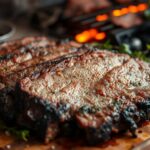Uncategorized
Master the Art of Grilling Juicy BBQ Chicken
Why settle for dry, flavorless chicken when you can learn how to cook BBQ chicken to grill juicy chicken perfection? Dive into our ultimate guide designed to help you transform your backyard grilling into a culinary masterpiece. We’ll uncover the secrets behind achieving mouthwatering results every time you grill.
With our expert tips and techniques, you’ll master the perfect grilled BBQ chicken recipe that will have everyone coming back for seconds. From understanding the nuances of temperature control to selecting the best cuts of meat, and seasoning them to perfection, we’ve got you covered. Prepare to elevate your BBQ chicken game like never before!
Key Takeaways
- The safe internal temperature for chicken is 165°F.
- Preheating the grill for 10-15 minutes ensures even cooking.
- Brining chicken boosts moisture retention and enhances juiciness.
- Using a two-zone setup helps in even cooking and prevents burning.
- Bone-in, skin-on chicken pieces retain more moisture than boneless, skinless cuts.
- Marinating chicken for at least 30 minutes infuses flavors and softens meat.
- Allowing chicken to rest for 5 minutes redistributes juices, making it more succulent.
Understanding Why Chicken Dries Out
Grilling chicken can be tricky because it tends to dry out. To keep chicken moist, it’s important to know what affects moisture.
The Lean Nature of Chicken
Chicken is naturally lean, meaning it has less fat than other meats. This low fat is a big reason chicken dries out fast on the grill. Fat helps keep meat moist, so we need special bbq chicken grilling techniques for chicken.
Impact of Overcooking
Overcooking makes chicken dry and tough. When chicken is grilled too long, its proteins tighten and push out moisture. To prevent this, take the chicken off the grill when it hits 165°F. This step is key to tender chicken.
Proper Temperature Control
Keeping the grill at the right temperature is crucial for juicy chicken. Grilling chicken breasts at 400°F for about 8 minutes works well. Using a meat thermometer helps avoid overcooking. This careful temperature control is essential for juicy, tasty chicken.
Selecting the Best Chicken Cuts for BBQ
Choosing the right chicken cuts is key to a great BBQ. You might love the juiciness of chicken thighs or the crispy skin of drumsticks. We’ll look at the benefits of bone-in, skin-on pieces and how to cook chicken by part.
Benefits of Bone-In, Skin-On Pieces
Going for bone-in, skin-on chicken changes the game for your bbq chicken recipe. The bone keeps the meat moist, and the skin gets crispy. This combo is perfect for a juicy inside and a crispy outside.
Chicken thighs, especially bone-in, are great because of their fat. This fat makes the meat juicy and flavorful. Over 30,000 people have saved a recipe that shows how good these cuts are.
Choosing Between Thighs, Drumsticks, Breasts, and Wings
Each chicken cut has its own taste and texture. This makes each one a great choice for your best bbq chicken recipe. Here’s a quick look:
| Chicken Cut | Benefits | Cooking Time | Ideal Temperature |
|---|---|---|---|
| Thighs (Bone-In) | Juicy with high fat content, forgiving cooking conditions | 15-20 minutes | 160°F indirect, 165°F after resting |
| Drumsticks | Moist and flavorful, fun to eat | 15-20 minutes | 160°F indirect, 165°F after resting |
| Breasts (Boneless, Skinless) | Lean, versatile, quick cooking | 10-15 minutes | 150°F indirect, 165°F after resting |
| Wings | Crispy skin, great with a variety of sauces | 10-15 minutes | 160°F indirect, 165°F after resting |
Knowing these differences helps you cook bbq chicken to bring out its flavors. Whether you’re starting with drumsticks or trying wings, these tips will help you.
How to Cook BBQ Chicken
Learning to cook BBQ chicken is about choosing the right method, keeping the temperature right, and making sure the meat is safe to eat. We’ll cover these key points to help you make delicious BBQ chicken, whether it’s grilled or homemade.
Grilling vs. Smoking
When cooking BBQ chicken, you can grill or smoke it. Grilling uses direct heat for a quick 25 to 30 minutes. Smoking cooks it slowly, giving a deeper flavor. Think about the time and taste you want to choose the best method.
Optimal Grilling Temperature
For grilling, heat your grill to about 450°F. Clean the grate and let it get hot. Cook the chicken for 5-6 minutes on one side and 4-5 on the other. Add BBQ sauce for the last 2 minutes to enhance flavor without burning.
Using a Meat Thermometer
A meat thermometer is key for safe and juicy chicken. For breasts, aim for 160°F to 165°F. For thighs and drumsticks, go for 170°F to 175°F. This ensures your chicken is cooked just right.
| Nutrient | Amount per Serving | Recommended Daily Intake |
|---|---|---|
| Calories | 190 kcal | 656 kcal |
| Carbohydrates | 15 g | 21 g |
| Protein | 24 g | 50 g |
| Fat | 3 g | 40 g |
| Saturated Fat | 1 g | 11 g |
| Cholesterol | 72 mg | 198 mg |
| Sodium | 498 mg | 1070 mg |
| Potassium | 501 mg | 636 mg |
| Fiber | 1 g | 1 g |
| Sugar | 12 g | 16 g |
| Vitamin A | 114 IU | 741 IU |
| Vitamin C | 2 mg | 5 mg |
| Calcium | 17 mg | 49 mg |
| Iron | 1 mg | 3 mg |
Prepping Your Chicken: The Brine and Marinade
Getting your chicken ready right can make a big difference. Brining and marinating are key steps. They add flavor and keep the chicken tender and juicy.
Basics of Brining
Brining helps keep the chicken moist, so it doesn’t dry out. A simple brine of 1 cup water to 1/4 cup salt can make your chicken juicier. It’s important to chill the brine with ice before adding the chicken.
This mix will keep the chicken tender and flavorful. It’s a great way to enhance the taste of your BBQ chicken.
- Time: Brining should last between 1-2 hours for optimal results.
- Temperature: Cook brined chicken on the grill at 400-450°F.
- Volume: Brined chicken takes longer to cook because it’s more moist.
Brined chicken takes about 2 hours to prepare and cook. Let it rest for 5 minutes after grilling to keep the juices in. The safe temperature for chicken is 165°F.
Creating Flavorful Marinades
Creating the best marinades for BBQ chicken is all about the right mix. A classic marinade includes citrus juice, vinegar, oil, and spices. The acid tenderizes the meat, while the oil and spices add bold flavors.
- Time: Marinate the chicken for at least 30 minutes or up to overnight for deeper flavor.
- Balance: Acidity from ingredients like lemon juice or vinegar tenderizes, while spices add depth.
Whether you marinate for a short time or overnight, the result is juicy BBQ chicken. Brining and marinating together make your chicken a hit at any event. Remember to add BBQ sauce 5-8 minutes before the chicken reaches 140-145°F to avoid burning and get a perfect glaze.
Seasoning for Maximum Flavor
Getting tender grilled chicken is more than just cooking. It starts with the right seasoning. The spices you pick can make your BBQ chicken taste amazing. Let’s look at how to pick and use spices for the best homemade BBQ chicken.
Choosing the Right Spices
When making the perfect seasoning for BBQ chicken, balance is important. Mix heat and sweetness for a deeper flavor. Common spices include:
- Chili powder
- Garlic powder
- Onion powder
- Paprika
- Thyme
- Black pepper
- Cumin
- Cayenne pepper
- Brown sugar
These spices give BBQ its unique taste. They help make your homemade BBQ chicken delicious.
Applying Dry Rubs and Spices
Start by mixing your spices. Then, rub them all over the chicken for even coverage. This not only seasons the meat but also creates a juicy crust.
Let the chicken sit with the rub for at least 15 minutes. But, resting it for 30 minutes or more is even better. Remember, patience is key for tender, flavorful chicken.
| Spice | Quantity |
|---|---|
| Chili Powder | ¼ cup |
| Paprika | 1 tablespoon |
| Thyme | 1 tablespoon |
| Salt | 2 teaspoons |
| Garlic Powder | 2 teaspoons |
| Black Pepper | 1 teaspoon |
| Cumin | 1 teaspoon |
| Cayenne Pepper | 1 teaspoon |
| Brown Sugar | 1 tablespoon |
Using a balanced spice rub is key for tender chicken. It makes sure every piece of your BBQ chicken is full of flavor. Enjoy the delicious results of your expertly seasoned BBQ chicken!
Mastering the Grill Setup
Getting the perfect BBQ chicken starts with setting up your grill right. This step is key to making sure your chicken is juicy and full of flavor.
Preheating the Grill
First, heat your grill to about 450°F. This high heat is important for searing the chicken. It creates a tasty crust and keeps the juices inside. Make sure to preheat for 10-15 minutes to avoid hotspots that can mess up your cooking.
Creating a Two-Zone Setup
A two-zone setup is a game-changer for BBQ chicken. You need one side for direct high heat and the other for indirect lower heat. Sear the chicken on the hot side until it’s golden brown. Then, move it to the cooler side to finish cooking.
This method helps the chicken cook evenly without burning. It’s a key step to avoid dry chicken.
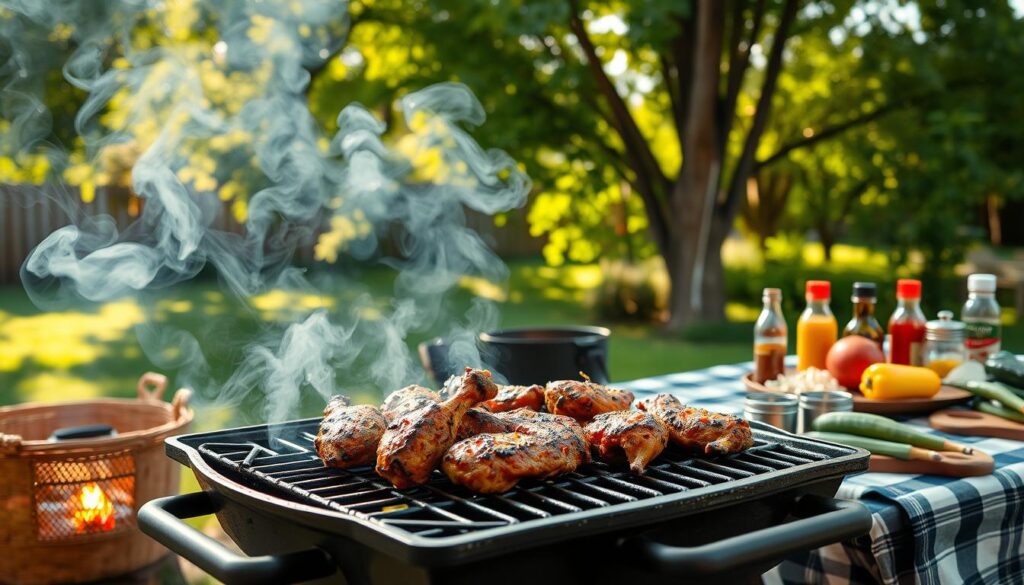
| Chicken Cut | Suggested Cooking Time | Internal Temperature |
|---|---|---|
| Boneless Chicken Breasts | Approx. 15 minutes | 165°F |
| Boneless Chicken Thighs | Approx. 20-25 minutes | 165°F |
| Bone-In Chicken Thighs | Approx. 35-45 minutes | 165°F |
| Chicken Wings | Approx. 30-35 minutes | 165°F |
Essential Grilling Techniques
Learning bbq chicken grilling techniques is key to making your chicken taste great and stay juicy. It’s all about managing flare-ups, knowing when to flip the chicken, and using the grill’s lid right. The secret to grilling juicy chicken is keeping the temperature steady and controlling how long you cook it.
Handling flare-ups is very important. If a flare-up occurs, move the chicken to a cooler part of the grill. Then, put it back once the flames die down. This way, you avoid burning the chicken while cooking it to perfection.
Flipping your chicken at the right times is also crucial. Boneless skinless chicken breasts cook for 6-8 minutes per side over medium heat. But, bone-in thighs and drumsticks need 25-30 minutes, cooked over indirect heat to stay moist.
Timing is everything in making the perfect grilled BBQ chicken recipe. Grill chicken wings for 20-25 minutes, turning them often for even cooking. Use a meat thermometer to check the chicken’s internal temperature, aiming for 165°F to keep it moist.
Using the grill lid correctly helps you get even heat, just like an oven. Preheat the grill for 10-15 minutes until it’s hot, between 375°F to 450°F. This high heat at the start seals in the juices and flavors.
By using these bbq chicken grilling techniques, you’ll have a great barbecue that everyone will love. Remember these tips, and you’ll be grilling juicy chicken like a pro every time.
The Importance of Resting Your Chicken
Resting your grilled chicken is as important as cooking it. This step is key to getting juicy and tender chicken. It makes your meal better.
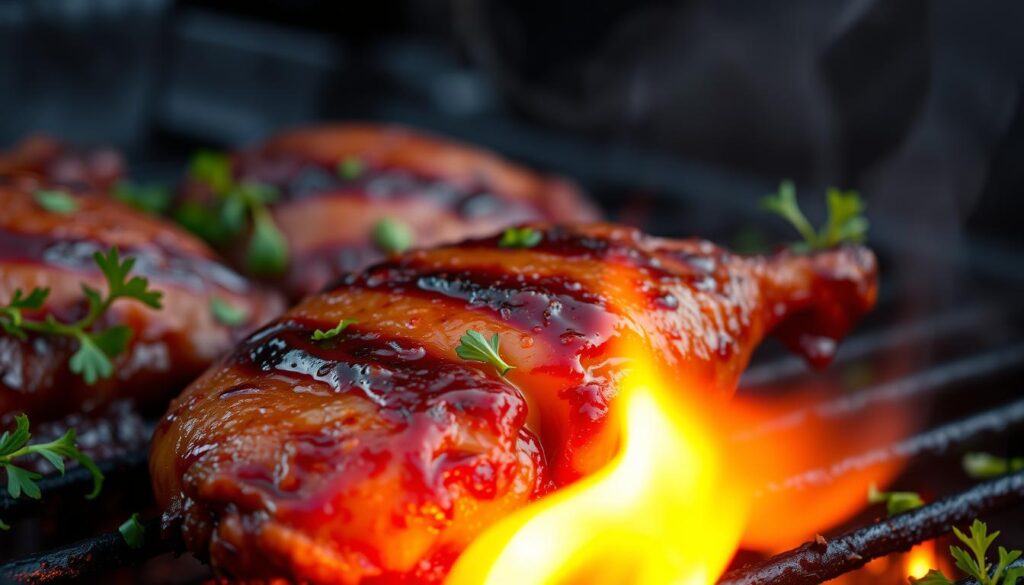
Why Resting Matters
Resting the chicken is a crucial step in grilling it right. Letting it rest for about 5 minutes helps the juices spread evenly. If you cut it too soon, the juices will run out, making it dry.
To keep it warm and even, cover it loosely with foil. This helps the chicken stay juicy.
How Long to Rest Your Chicken
For best results, let the chicken rest for about 5 minutes. This makes it juicy and flavorful. Always check that the chicken is at least 165ºF before resting it.
This ensures it’s cooked and safe to eat. Plus, it stays juicy and tasty.
Perfect Timing: When to Apply BBQ Sauce
Getting the timing right for BBQ sauce on chicken is key. Many grillers apply sauce too soon and keep basting, which can burn the chicken. To get the best results, it’s important to know when and how to apply the sauce.
Avoiding Burnt Sauces
BBQ sauces with a lot of sugar can burn easily if the heat is too high. It’s best to add the sauce in the last 10 to 15 minutes of cooking. This way, the sauce caramelizes and sticks without burning.
For juicy chicken, bake at 400 degrees Fahrenheit. Start with chicken thighs at 25 minutes before adding the first sauce layer.
Layering for a Glazy Finish
To get a glazy finish, use thin layers of BBQ sauce. Let each layer caramelize before adding the next. This builds flavor and a glossy look that’s both attractive and tasty.
After each layer, cook for 7 more minutes. Repeat this a few times for the best results. For a crispy finish, broil the chicken briefly after the last sauce layer.
Choosing the right BBQ sauce is also crucial. Look for a thick sauce that sticks well. Adding ingredients like peach preserves, garlic, and hot sauce can make your chicken extra flavorful. The right sauce and timing are essential for perfect BBQ chicken.
Quick Tips for Preventing Dry Grilled Chicken
Grilling chicken right is all about the right techniques and practices. Here are some tips to make your grilled chicken moist and delicious every time.
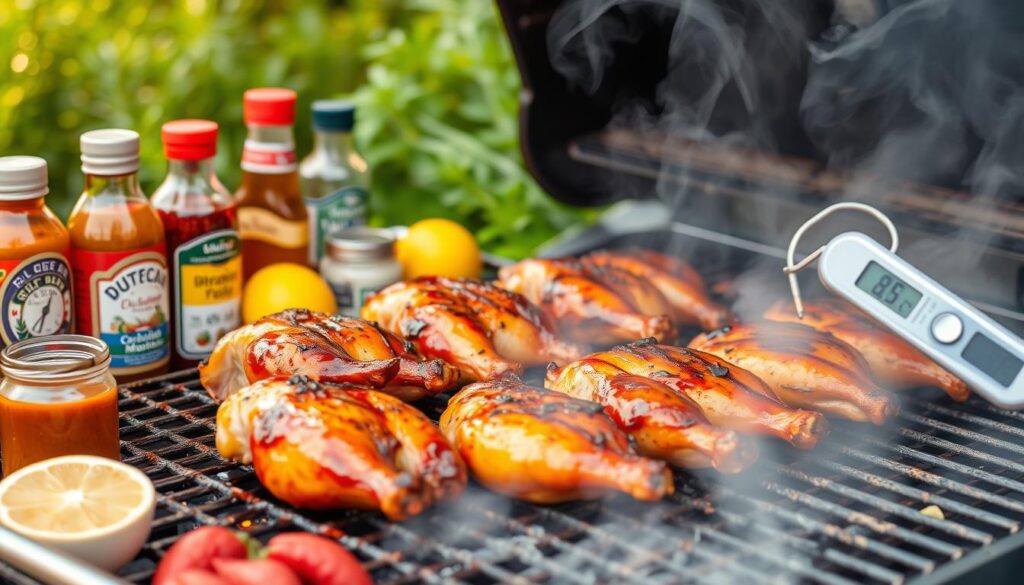
- Preheat the Grill: Always preheat your grill to high heat, approximately 375-400°F (190-204°C), to ensure proper searing and prevent sticking.
- Even Thickness: Pound chicken breasts to an even thickness of ½-inch to ensure uniform cooking and prevent dry, overcooked edges.
- Proper Marination: Marinate your chicken for at least 4 hours, or preferably overnight. This deeply infuses flavors and helps with how to prevent dry grilled chicken.
- Brining: Brining your chicken for a minimum of 30 minutes forms a moisture-retaining shield, making it more forgiving to slight overcooking.
- Indirect Grilling: Utilize a two-zone cooking method by starting with high heat searing and finishing the chicken on medium-low or indirect heat.
- Internal Temperature: Always monitor the internal temperature with a meat thermometer. Remove chicken from the grill at around 160°F, allowing it to rise to the recommended 165°F while it rests.
- Resting Time: Let the chicken rest for 3-4 minutes post-grilling. This redistributes the juices, ensuring a moist and flavorful bite.
- Avoid High Heat: Grill chicken on medium heat to prevent external charring and internal undercooking.
- Basting: Basting chicken with flavorful liquids during grilling enhances both moisture and taste.
- Grilled Vegetables: Cooking vegetables like zucchini and bell peppers alongside chicken can increase the moisture content in the cooking environment.
- Beer Can Method: For whole chickens, the beer can method can steam the chicken internally, resulting in moist meat.
- Seasoning: Salt your chicken before grilling to seal in moisture and enhance flavor as it fades during cooking.
- Even Cooking: Allow marinated chicken to rest at room temperature for 15-30 minutes before grilling for more even cooking.
- Grill Setup: Create a two-zone setup for optimal grilling by searing on high heat first and finishing on indirect heat to retain moistness.
| Step | Description |
|---|---|
| Grill Preheat | High heat, 375-400°F (190-204°C). |
| Even Thickness | Pound to ½-inch. |
| Marination | Minimum 4 hours. |
| Brining | At least 30 minutes. |
| Grill Method | Two-zone cooking. |
| Temperature | Remove at 160°F, rest to 165°F. |
| Resting Time | 3-4 minutes. |
| Avoid High Heat | Use medium heat for even cooking. |
| Basting | Enhances moisture and flavor. |
| Grilled Vegetables | Increases moisture in the environment. |
| Beer Can Method | Steam whole chicken internally. |
| Seasoning | Salt for moisture retention. |
| Room Temperature | Let rest for 15-30 minutes before grilling. |
| Grill Setup | Sear on high, finish on indirect heat. |
With these tips, you can make your BBQ chicken moist and flavorful. Mastering how to keep chicken moist on the grill and how to prevent dry grilled chicken will impress your guests with every juicy bite.
Delicious BBQ Chicken Recipes
Make your next grilling session unforgettable with these tasty BBQ chicken recipes. Whether you’re looking for a great BBQ chicken recipe for family gatherings or a simple one for weeknights, these dishes will impress. From BBQ chicken breast to smoky wings and flavorful kabobs, each recipe offers a delightful experience.
Classic BBQ Chicken Breast Recipe
A perfectly cooked BBQ chicken breast is unbeatable. To keep it juicy, brine the chicken for 2 to 4 hours. This step helps keep the chicken tender while grilling. Cook the breasts on medium heat for 6-8 minutes per side. Always check the internal temperature with a meat thermometer to ensure it reaches 165°F.
Smoky BBQ Chicken Wings
Smoky BBQ chicken wings are great for any event. Grill the wings for 20-25 minutes, turning them often for even cooking. For a deep smoky flavor, finish them with indirect heat until they reach 165°F. Marinating the wings for at least 2 hours will boost the flavor.
BBQ Chicken Kabobs
BBQ chicken kabobs are fun to make and loved by all. Make sure the chicken is marinated for at least 2 hours. This keeps it moist, even with small pieces. Grill the kabobs on medium-high heat, turning them every few minutes for even cooking. Aim for an internal temperature of 165°F for safe and tasty kabobs.
- Brine chicken for 2-4 hours to maximize moisture retention.
- Use a meat thermometer to check the internal temperature regularly.
- Apply a combination of rubs, marinades, and injections for enhanced flavor and juiciness.
| Recipe | Grilling Time | Marination Time | Internal Temperature |
|---|---|---|---|
| Classic BBQ Chicken Breast | 6-8 minutes per side | 2-4 hours brining | 165°F |
| Smoky BBQ Chicken Wings | 20-25 minutes, frequent turning | 2+ hours marinating | 165°F |
| BBQ Chicken Kabobs | Regular turning every few minutes | At least 2 hours marinating | 165°F |
With these recipes, you’re on your way to becoming a BBQ chicken master. Whether it’s the classic BBQ chicken breast, smoky wings, or flavorful kabobs, each dish is a hit. They’re the best BBQ chicken recipes you and your guests will love and remember.
Serving Ideas and Pairings
Enhancing your BBQ chicken experience is easy with the right accompaniments. Choose complementary side dishes and sauces to elevate the flavors. This makes your meal unforgettable.
Complementary Side Dishes
Pairing BBQ chicken with the right side dishes is key. Creamy macaroni salad, tangy vinegar coleslaw, and hearty baked beans are popular choices. For a fresh twist, try grilled vegetables or a tomato cucumber salad.
Busy hosts can opt for quick sides like Instant Pot Mac & Cheese or peach caprese salad. These are perfect for last-minute preparations.
The variety of BBQ chicken side dishes is vast. There’s something for everyone. Here are some stats on popular sides and their prep times:
| Side Dish | Preparation Time |
|---|---|
| Instant Pot Mac & Cheese | 30 minutes |
| Peach Caprese Salad | 30 minutes |
| Grilled Peach and Burrata Salad | 20 minutes |
| Baked Beans | 40 minutes |
| Watermelon Basil Salad | 15 minutes |
| Crispy Baked Avocado Fries | 30 minutes |
Best Sauces and Toppings
The right sauces and toppings can elevate your BBQ chicken. Try a tangy vinegar-based BBQ sauce, a sweet and spicy glaze, or a rich bourbon sauce. For a twist, serve with Greek yogurt tzatziki or mango salsa.
Combining traditional and innovative dishes and toppings will please your guests. From creamy mac and cheese to crispy avocado fries, the right pairings are key.
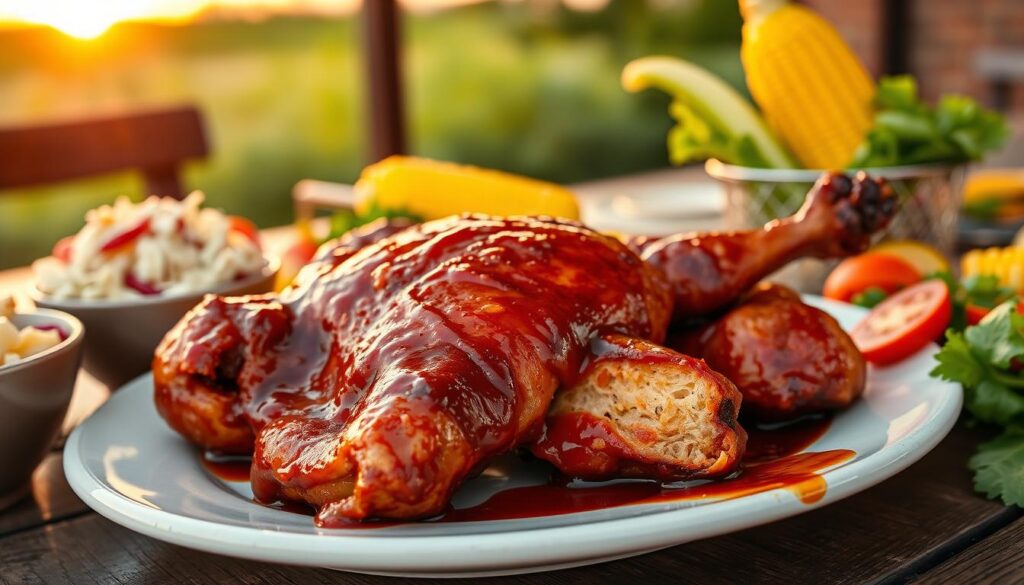
Conclusion
Now you can make juicy BBQ chicken like a pro. This guide showed you how to make sure your chicken is always tender and tasty. You learned about choosing the right cuts, brining, and marinating.
These steps are key to a great grilled BBQ chicken recipe. We also talked about the benefits of bone-in, skin-on pieces and the importance of resting the chicken after grilling.
By following these tips, you’ll impress everyone with your grilling skills. Try different marinades and rubs, like Laajawab Rocky Smoky Chicken Rub. Also, learn to use medium-high heat and a meat thermometer.
Whether you’re making BBQ chicken breasts, wings, or kabobs, the results will be amazing. Pair your chicken with sides like coleslaw, potato salad, or grilled veggies for a full meal. Now you know how to make BBQ chicken that’s both tasty and memorable. Happy grilling and enjoy your delicious BBQ chicken!
FAQ
How can I prevent chicken from drying out on the grill?
To keep chicken moist, control the grill temperature well. Use a two-zone setup and brine the chicken. Also, check the chicken’s internal temperature with a meat thermometer.
What are the best chicken cuts for grilling?
Bone-in, skin-on pieces like thighs, drumsticks, and wings are great for grilling. The bones keep the meat moist, and the skin adds flavor by rendering fat.
What grilling techniques help ensure juicy BBQ chicken?
To grill juicy chicken, preheat the grill and set up a two-zone area. Sear the chicken over direct heat, then finish cooking over indirect heat. Brining and marinating also add moisture and flavor.
Why does my chicken sometimes come out dry?
Chicken can dry out because it has low fat. Overcooking tightens the lean protein, losing moisture. Keep the temperature below 165°F to prevent drying.
How do I achieve the perfect grilled BBQ chicken?
For perfect BBQ chicken, manage the grill temperature and brine or marinate the meat. Use dry rubs for flavor and a meat thermometer to avoid overcooking. Let the chicken rest after grilling to keep juices in.
What are the benefits of brining chicken before grilling?
Brining makes chicken juicier and more flavorful. A simple salt-water brine, especially with herbs and spices, can make a big difference.
How should I apply BBQ sauce to grilled chicken?
Apply BBQ sauce in the last few minutes of grilling to avoid burning. Brush on thin layers, letting each layer caramelize before adding the next. This creates a rich, glazy coating.
What temperature should I grill chicken at for the best results?
Grill chicken at a medium-high temperature, between 375°F to 450°F. Use a two-zone setup to sear over direct heat and finish over indirect heat for even cooking.
How long should I let my chicken rest after grilling?
Let your chicken rest for about 5 minutes after grilling. This allows juices to redistribute, enhancing moisture and flavor. Covering with foil keeps it warm.
What spices work best for seasoning BBQ chicken?
Use a mix of paprika, garlic powder, onion powder, black pepper, and a bit of cayenne pepper. Apply generously before grilling to seal in juices.
Can I grill chicken breasts without them drying out?
Yes, you can grill chicken breasts without drying them out. Brine them, use a meat thermometer, and apply a flavorful marinade. Grilling over indirect heat also helps prevent dryness.
What are some quick tips for getting juicy BBQ chicken?
For juicy BBQ chicken, use bone-in, skin-on cuts, brine the chicken, and preheat your grill. Create a two-zone setup, avoid overcooking, and let the chicken rest after cooking. These steps keep the meat moist and flavorful.
How can I add extra flavor to my BBQ chicken?
To add flavor, use marinades, dry rubs, and brines with herbs, spices, garlic, and citrus. Apply BBQ sauce in the final grilling minutes for a rich glaze.
Types of Smokers
Imagine this: over 75% of BBQ fans use pellet smokers for tender meat. Entry-level pellet grills start at $400, but top models like the Yoder can cost up to $2500. This shows the wide range of smokers out there.
For BBQ lovers, knowing about different smokers is key. There are electric, pellet, charcoal, propane, and offset smokers. Each type has its own features and suits different cooking styles. Whether you prefer the ease of electric or charcoal for smoky flavor, there’s a smoker for everyone.
Key Takeaways
- Pellet smokers offer a “set and forget” cooking style, with temperatures ranging from 160-500°F.
- Charcoal smokers are ideal for authenticity, producing a deep smoky flavor but require more maintenance.
- Gas smokers are praised for their simplicity, ease of temperature control, and quicker startup times.
- Offset smokers can cook massive amounts of food, with high-quality models costing over $2000.
- Electric smokers are user-friendly, similar to operating a microwave oven.
Introduction to Smokers
Smoking food has been around for ages, mainly for keeping food fresh. Now, it’s all about making food taste better and feel more tender. Choosing a smoker means thinking about space, fuel, effort, and cost.
For beginners, knowing the basics is key. Smokers burn fuels like charcoal, wood pellets, propane, and electricity. Each fuel gives food its own special flavor. Hardwoods like hickory, oak, and apple are favorites for that smoky taste.
It’s important to know how to use and care for a smoker. Backyard BBQ smokers cost between $500 and $2500. With good care, they can last 30 to 35 years.
Here’s a list of barbecue essentials you need to know:
- Fuel Type: Choose from charcoal, wood pellets, and more.
- Temperature Control: Recipes often call for 200 to 220 degrees Fahrenheit.
- Meat Selection: Brisket, pork shoulder, and poultry are favorites.
- Cooking Time: Smoking can take from 1 hour to over 20 hours.
- Flavor Impact: The wood used greatly affects the taste of smoked food.
- Maintenance and Upkeep: Good care makes your smoker last for decades.
There are many smokers for beginners to choose from, from simple to high-end models. Knowing your options helps you pick the right smoker for your needs. Whether you prefer a classic charcoal smoker, an electric model, or a pellet grill, the goal is to find one that fits your cooking style and improves your BBQ experience.
What Are the Different Types of Smokers
Knowing what are the different types of smokers can really improve your BBQ game. Each smoker has its own perks and fits different tastes. So, it’s key to compare them to find the right one for you. Let’s explore the main types of smokers and what makes them special:
Electric Smokers: These smokers keep the temperature steady and run on electricity. They’re perfect for those who want a hassle-free BBQ experience.
Charcoal Smokers: Charcoal smokers give off amazing flavors. But, they need constant attention to keep the fire going. They might cost more to use, but the taste is worth it.
Pellet Smokers: Pellet smokers use wood pellets for heat. They offer easy temperature control and a hands-off smoking experience. But, they can be pricey and have parts that might break.
Propane Smokers: Propane smokers are easy to control and keep the heat steady. They’re also easy to find parts for. But, you need to watch the propane levels. They’re great for taking on the go.
Every smoker type—electric, charcoal, pellet, and propane—can make delicious food. So, picking the right one depends on what you value most. For me, an electric smoker was the best choice because it’s easy to use and versatile.
In short, picking the best smoker is about finding a balance. You might want something easy to use, or you might prefer the authentic taste of charcoal. Knowing what are the different types of smokers helps you choose the one that fits your cooking style and needs.
Electric Smokers
Electric smokers have changed the game in easy barbecue smoking. They offer convenience and simplicity for both newbies and experts. These smokers use electricity to keep the temperature steady, making smoking easy and hassle-free.
How They Work
Electric smokers heat up the cooking chamber with an electric element. The temperature is controlled by electronics, allowing for precise adjustments. This makes smoking vegetables and fish quickly and reliably.
Pros and Cons
Electric smokers are great for those who want it easy:
- Convenience: They start quickly and are easy to use, perfect for a hassle-free experience.
- Consistency: They keep temperatures steady, which is great for smoking vegetables and fish quickly.
- Safety: They have less risk of flare-ups and are mess-free.
- Range: Prices range from $180 to $400, fitting different budgets.
But, there are some downsides to consider:
- Flavor: Some say electric smokers don’t have as strong a smoke flavor as traditional methods.
- Temperature Control: They can struggle to keep a high temperature, especially compared to indoor ovens.
The Masterbuilt electric smoker is a standout. It’s 26 x 41 x 20 inches, weighs 73 pounds, and has a cooking area of 970 square inches. Its 800-watt power allows for temperatures up to 275 degrees Fahrenheit, ideal for beginners.
| Brand | Cooking Area | Power | Temperature Range |
|---|---|---|---|
| Masterbuilt | 970 sq. in. | 800 watts | Up to 275°F |
| Cuisinart | 548 sq. in. | 1500 watts | 100-400°F |
| Bradley Smoker | 806.4 sq. in. | 1000 watts | 86-320°F |
| Char-Broil Analog | 544 sq. in. | 1200 watts | 100-350°F |
Overall, electric smokers are a great choice for beginners or anyone looking for an easy smoking experience.
Pellet Smokers
Pellet smokers are getting more popular for their ease and flexibility. They mix automated temperature control with the taste of wood, offering a special grilling experience. Let’s explore how they work and their good and bad points.
How They Work
A pellet smoker burns wood pellets as fuel. These pellets are fed into a fire pot by an auger. An igniter starts the fire, creating heat and smoke. The smoker’s automated system keeps the temperature steady by controlling the pellets and fan speed.
This lets users set exact temperatures, often within 5 degrees. The temperature stays within 10 degrees of the setpoint.
Pros and Cons
Pellet smokers have many benefits:
- Consistency: The automated system ensures even cooking, no matter the outside temperature.
- Versatility: These smokers can grill, roast, smoke, and even bake, making them very useful.
- Simplicity: They are easy to use, needing little help during cooking.
But, there are some downsides too:
- Cost: Pellet smokers are pricier than gas grills, starting at around $400.
- Electricity Dependency: They need electricity to work the automated system and auger.
Pellet smokers have cooking areas from 200 to over 700 square inches. They suit both small family events and big commercial needs. Their ease and versatility are big pluses, but their cost and need for electricity are things to think about.
Charcoal Smokers
Charcoal smokers are known for their authentic barbecue flavor. They use charcoal, which adds a smoky taste to food. This requires more effort than other smokers. Whether you’re a pro or new to grilling, knowing about top charcoal smokers can improve your BBQ.
Testing showed the best charcoal smokers after 50 hours. The Dyna-Glo Signature Series Vertical Offset Charcoal Smoker was the top pick. It has 1,382 square inches of cooking area.
The Pit Barrel Cooker Classic Package was a close second. It has a unique design and 269 square inches of cooking space. This is great for hanging meat vertically.
The Masterbuilt vertical cabinet charcoal smoker was the best splurge. It has 1,320 square inches of cooking surface. The Wide Body Vertical Offset smoker is best for big meals, with 1,890 square inches of space.
These smokers were tested with quick smokes and longer sessions. The best had lots of space, racks, and hooks. This ensures good air flow and temperature control.
The Dyna-Glo Signature Series was the top smoker. It’s big, with 45.5 x 24.9 x 58.8 inches of space. The Pit Barrel Cooker and Masterbuilt smokers also stood out. The Wide Body Vertical Offset smoker is great for those on a budget.
What makes charcoal smokers special is the experience they offer. The effort to manage charcoal and temperature is worth it. It results in delicious, authentic BBQ every time.
Propane Smokers
Propane smokers, also known as gas smokers, are a simple alternative to traditional smoking. They are perfect for beginners who want easy and controlled smoking.
How They Work
Propane smokers use propane gas to heat the smoking chamber well. The gas burners let users control the temperature exactly. This ensures consistent cooking results. They heat up fast, making them easier to use than charcoal smokers.
Pros and Cons
Propane smokers have many benefits:
- They heat up quickly and have easy temperature control.
- Managing gas is easier than charcoal.
- They render fat well and add a nice char to meat.
But, they also have some downsides:
- They might not give as deep a smoke flavor as charcoal or wood.
- They can have temperature swings, affecting consistent smoking.
- They can have gas leaks, so regular maintenance is needed.
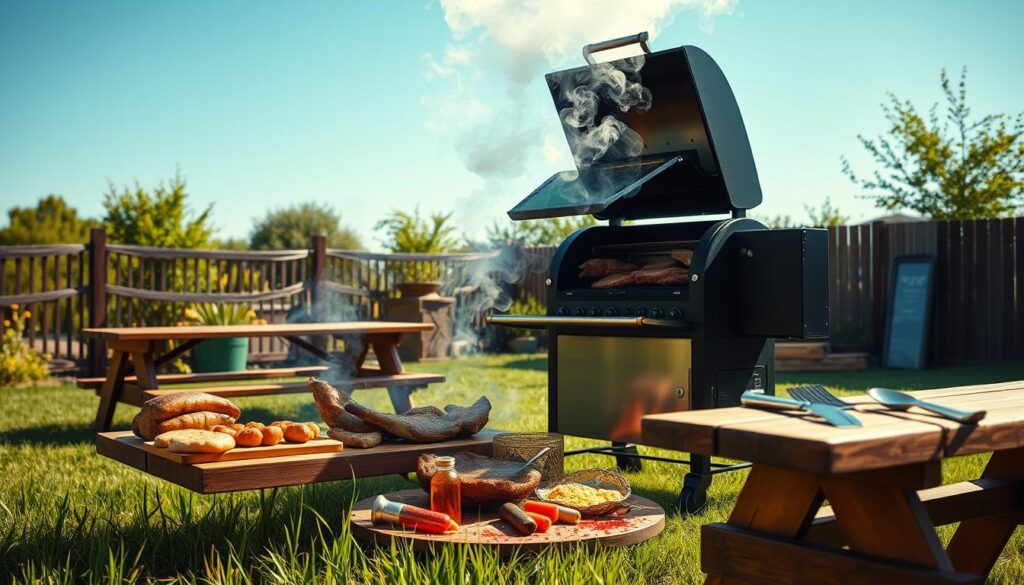
| Gas Smoker Model | Dimensions | Cooking Area | Number of Racks | Price |
|---|---|---|---|---|
| Camp Chef Smoke Vault | 16 x 24 x 24 inches | 903 square inches | 2 + 1 jerky rack | $450 |
| Pit Boss | 47 x 23 x 22 inches | 720 square inches | 4 | $350 |
| Char-Broil Gas Smoker | 46 x 22 x 22 inches | 595 square inches | 4 | $250 |
| Cuisinart Gas Smoker | 46 x 20 x 20 inches | 784 square inches | 4 | $300 |
In summary, propane smokers are a convenient and efficient way to enjoy smoked foods. They offer ease of use, good performance, and are affordable.
Offset Smokers
Offset smokers are beloved by many grilling fans, including me. They have a separate firebox on the side of the main cooking area. This design ensures indirect heat and smoke for great flavor.
How They Work
Fuel like wood or charcoal burns in the firebox, creating smoke. This smoke goes into the main cooking area. This setup cooks food slowly, giving it deep smoky flavors.
Modern designs, like square fireboxes, are popular for being easy to use. Round fireboxes are loved for their classic look and wood fire management.
The firebox’s size is key for good performance. A length of 24 to 28 inches works well for most backyard offsets. The firebox’s width should match the cooking chamber to avoid cold spots. Using 1/4-inch thick steel for the firebox makes it durable. Insulated fireboxes need less wood, but might change the smoke flavor.
Pros and Cons
Offset smokers have both good and bad points:
- Pros:
- Flavor Control: They offer unmatched flavor due to smoke exposure.
- Capacity: They can cook a lot of food, perfect for big gatherings.
- Cons:
- Temperature Management: Keeping a steady temperature is hard and needs constant attention.
- Cost: High-quality smokers are pricey but worth it for their performance and durability.
Brands like the Dyna-Glo Signature Series Vertical Offset Charcoal Smoker have big cooking areas. With 1,382 square inches, they’re great for any smoking session. The right design and quality make every barbecue a success.
Choosing the Best Smoker for Beginners
When picking the best smoker for beginners, it’s key to think about ease and flavor. Electric smokers are great for newbies because they’re easy to use. But, they might not add as much flavor to your meat.
Pellet smokers are another good choice for beginners. They’re known for being easy to use and offer consistent smoke. This makes them perfect for getting that smoky taste without much work.
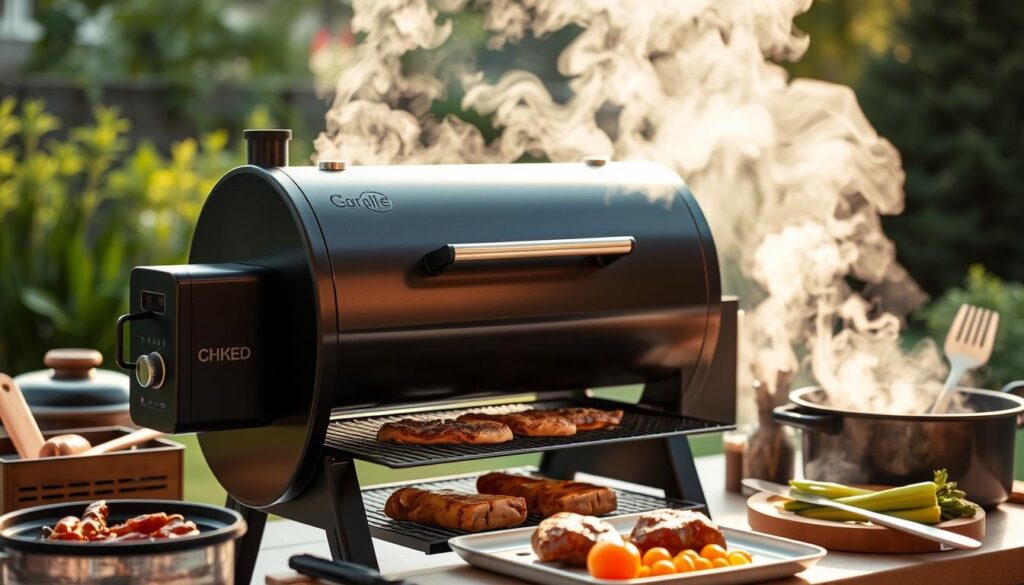
But, electric and pellet smokers can be pricey. For example, the Weber Smokefire EX6 Wifi Pellet Grill costs $1,300 on Weber’s site. Amazon has it for $1,219. Charcoal smokers, like the Weber Smokey Mountain Cooker, are more affordable at $419.
If you’re looking to spend a bit more, the Char-Griller Grand Champ is worth it. It costs $599, but you can find it for $549 at Home Depot. It’s known for its quality and versatility, making it a great choice for beginners and experts alike.
In summary, choosing the best smoker for beginners means looking at ease of use and flavor. Whether you choose electric, pellet, or charcoal, knowing what you want will help you pick the right one. As Ed Randolph from Handsome Devil BBQ says, “I have an arsenal of 15 smokers.” This shows that once you start smoking meat, you might want to get more!
Conclusion
Exploring different BBQ smokers shows that the right choice depends on what you like, your budget, and how involved you want to be. Each smoker has its own perks. For example, electric smokers make cooking easy, while offset and charcoal smokers offer deep, rich flavors that fans love.
Our look at smoking methods highlights how versatile these smokers are. Pellet smokers, like the Bubba Keg Grill & Smoker, are great because they’re easy to use and save fuel. Vertical smokers, such as the Char-Broil Silver and the Brinkmann Smoke ‘n Pit, are ideal for cooking many foods at once. This variety lets barbecue lovers try new things and get better at smoking.
In wrapping up, think about what you need and want before picking a smoker. Whether you’re new to grilling or have lots of experience, there’s a smoker that can take your skills to the next level. No matter your choice, these tips and suggestions are here to guide you. They aim to help you pick well and enjoy the tasty outcomes.
FAQ
What are the different types of smokers available?
There are many types of smokers. Each one is good for different cooking styles and tastes. You can choose from electric, pellet, charcoal, propane, and offset smokers. Each has its own benefits, like ease of use or flavor intensity.
Which smoker is best for beginners?
Beginners should start with electric or pellet smokers. They are easy to use because they control temperature automatically. This makes them perfect for those new to smoking.
How do electric smokers work?
Electric smokers use electricity to heat the cooking area. You set the temperature with an electronic control. This means you don’t have to add fuel manually.
What are the pros and cons of electric smokers?
Electric smokers are easy to use and keep a steady temperature. They start quickly. But, they might not have as strong a smoke flavor as other smokers. They also need electricity to work.
How do pellet smokers work?
Pellet smokers use an auger to feed wood pellets into a fire pot. This creates heat and smoke. They let you control the temperature precisely for even cooking.
What are the pros and cons of pellet smokers?
Pellet smokers are convenient and cook food evenly. They can also grill food. But, they cost more upfront and need electricity.
What are the advantages of charcoal smokers?
Charcoal smokers give food a classic smoky taste. They offer a hands-on smoking experience. But, they require more effort to manage temperature and clean.
How do propane smokers work?
Propane smokers use gas for heat. This makes temperature control and upkeep easier. They heat up fast and are simple to manage.
What are the benefits and drawbacks of propane smokers?
Propane smokers are easy to control and heat up quickly. They are also simple to maintain. But, they might not have as strong a smoke flavor as wood or charcoal smokers.
How do offset smokers work?
Offset smokers have a separate firebox that sends smoke into the cooking area. This indirect cooking method infuses food with deep flavor.
What are the pros and cons of offset smokers?
Offset smokers are great for cooking large amounts of food and adding deep flavor. But, they need skill to keep temperatures steady. They can also be more expensive, especially for high-quality models.
What should I consider when choosing a smoker as a beginner?
Beginners should think about how easy the smoker is to use and the flavor they want. Consider your cooking style, budget, and how involved you want to be. Electric and pellet smokers are good for beginners because they are easy to use.
25-gift-ideas-for-pellet-grill-owners-for-2025
Outdoor grilling brings joy and connection to my life. I cherish the evenings spent around a pellet grill. The smoky aroma and sizzle of food create lasting memories.
Finding the right gift for pellet grill owners shows you understand their passion. There are many great options, from practical tools to luxurious accessories. These gifts are perfect for any budget and interest.
Whether you’re surprising a seasoned grill master or a beginner, these gifts will make a difference. They will enhance their grilling experience and make you a gifting hero.
Key Takeaways
- Discover the best gifts for pellet grill owners suitable for 2025.
- Explore unique gifts for pellet barbecue lovers that add a personal touch.
- Find top gift ideas for pellet grilling enthusiasts to fit any budget.
- Consider practical, high-tech, and luxury options in one comprehensive guide.
- Enhance the spirit of outdoor cooking with thoughtful, curated gifts.
Introduction to Pellet Grill Gifts
Pellet grills are a hit among outdoor cooking fans. They mix convenience, precision, and flavor in a unique way. This makes them a top pick for serious grillers. So, finding pellet grill accessories for gifts is a big deal for those wanting to enhance their loved ones’ grilling fun.
Why Pellet Grill Owners Love Their Grills
Pellet grill owners love their grills for good reasons. The automatic feed system lets them control the temperature easily. This means they get consistent results every time. Plus, the wood pellets add a smoky flavor that’s hard to beat.
The grills are also super convenient. They often have features like electronic ignitions and Wi-Fi. This lets owners control and monitor their grills from afar.
What Makes a Gift Ideal for a Pellet Griller
When picking a gift for a pellet griller, think about a few things. The gift should match their current gear. Things like top-notch grill tools, temperature probes, or ways to store pellets are great. They make grilling better.
Personal touches, like custom meat branding irons or engraved tools, are also a hit. They show you care about their grilling hobby. It’s a thoughtful way to say you appreciate their passion.
Popular Pellet Grill Accessories
Every pellet grill lover knows the right accessories make grilling better. Let’s explore some top picks that make grilling easy, safe, and efficient.
Must-Have Tools for Easy Grilling
Some tools make grilling a lot easier. Here are some great gift ideas for pellet grill users:
- Grill Tongs and Spatula Set: A top-notch set for turning food without burning your hands.
- Pellet Tube Smoker: Adds a smoky flavor to food, making it taste better with little effort.
- Grill Mats: Non-stick mats that keep food from falling through the grates, making cleanup simple.
Top-rated Accessories for Safety and Efficiency
Safety and efficiency are key for pellet grilling. Here are some top picks:
- Heat-Resistant Gloves: Keep your hands safe from high temperatures while handling grills or tools.
- Grill Cover: Weather-resistant covers that protect the grill from the elements, helping it last longer.
- Cleaning Brush: A strong brush for cleaning grill grates, ensuring a clean cooking surface.
To wrap up, these accessories are not just useful but also great gifts for pellet grill users. They improve the grilling experience and ensure safety, making them excellent additions to any pellet griller’s collection.
| Accessory | Benefit | Rating |
|---|---|---|
| Grill Tongs and Spatula Set | Ease of flipping and turning food | 4.8/5 |
| Pellet Tube Smoker | Enhanced smoky flavor | 4.7/5 |
| Grill Mats | Non-stick and easy to clean | 4.6/5 |
| Heat-Resistant Gloves | Protection from high temperatures | 4.9/5 |
| Grill Cover | Weather protection | 4.8/5 |
| Cleaning Brush | Efficient grill cleaning | 4.7/5 |
Unique Gifts for Pellet Barbecue Lovers
Finding the perfect gift for a grill enthusiast can be tough. But, choosing something unique and personalized can make a big impact. If you know someone who loves their pellet grill, these thoughtful gifts can make their grilling better.
Personalized BBQ Tools
Personalized BBQ tools are a great gift for pellet grill lovers. Imagine their joy in using tongs, spatulas, and forks with their initials or a special message. These gifts are not only useful but also make their grilling setup special.
Exclusive Recipe Books
For those who enjoy trying new flavors and techniques, exclusive recipe books are a goldmine. Look for cookbooks with recipes made just for pellet grilling. These books have unique dishes and recipes that can improve any grill master’s skills. It’s a thoughtful gift that shows you care about their passion.
Top Gifts for Pellet Grilling Enthusiasts
Want to impress a pellet grill master? There are many great options to make their grilling better. From useful tools to fun gadgets, these gifts meet every enthusiast’s needs.
Gifts That Enhance the Grilling Experience
Great grilling gifts are both useful and fun. Here are some top picks for pellet smoking fans:
- Premium Wood Pellets: Traeger or Pit Boss pellets boost flavor and performance.
- Grill Lights: LED lights from Weber make nighttime grilling safe and easy.
- Bluetooth Speakers: JBL or Bose speakers add fun to their BBQ time.
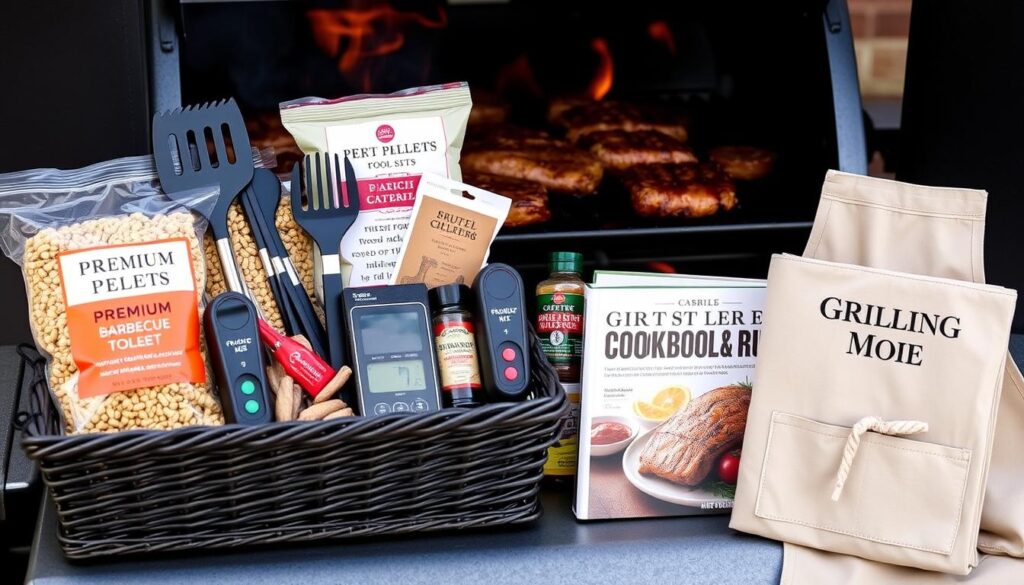
Surprise Your Pellet Grill Master with These Presents
Surprise your pitmaster with these thoughtful gifts. They’ll make their grilling sessions better:
| Gift Idea | Description |
|---|---|
| Pellet Storage Bins | Airtight bins keep pellets dry and organized, ensuring quality. |
| Grill Mats | Reusable mats make grilling foods like fish and veggies easier and cleaner. |
| Wireless Meat Thermometers | Remote temperature monitoring with thermometers from ThermoPro or MEATER. |
The best gifts for pellet grilling fans make any BBQ a feast. Whether it’s premium pellets or advanced thermometers, your gift will be a hit.
High-Tech Gifts for Pellet Grill Users
Technology is changing pellet grilling, making it easier to cook great meals. If you’re looking for the top-rated pellet grill gift suggestions this year, high-tech options are perfect. Let’s look at some advanced products that make grilling better.
Smart Thermometers and Probes
A smart thermometer or probe is a great high-tech gift for pellet grill users. Devices like the Meater+ or Weber iGrill connect via Bluetooth and Wi-Fi. This lets users check their grill’s temperature on their phone in real-time. These tools ensure meat is cooked just right every time.
- Meater+: Wireless, 165ft range, app-controlled
- Weber iGrill: Four-probe capacity, Bluetooth enabled
- ThermoPro TP20: Dual probe, wireless remote
Technological Gadgets to Optimize Grilling
For those who want to link grilling with their smart home, there are gadgets to help. From Wi-Fi-enabled grills to grill management software, these tools offer control and convenience. They let the grill master have more control and make grilling easier.
| Product | Features |
|---|---|
| Traeger Pro 780 | Wi-Fi support, app control, precise temperature control |
| Camp Chef Woodwind Wi-Fi | Smart Smoke technology, Wi-Fi enabled, PID controller |
| Green Mountain Grills Davy Crockett | Portable, Wi-Fi controlled, smart control |
Adding these top-rated pellet grill gift suggestions to your list will surely impress any pellet grill fan. These gadgets make grilling easier, more efficient, and fun.
What is a good gift that will be used with a pellet grill?
When looking for a gift for a pellet grill user, think about what they need and like. The best gifts are both useful and personal. They should make using the pellet grill more fun.
- Pellet Grill Cover: A sturdy grill cover is a great gift. It keeps the grill safe from the weather and lasts longer.
- Grill Mats: Grill mats make cleaning up easier. They also stop food from falling through the grates, making grilling smoother.
- Flavor Pellets: Special wood pellet flavors can make food taste better. They are a fantastic gift for pellet grill lovers.
When picking gifts for pellet grill users, think about what fits their cooking style. Here’s a quick look at some top picks:
| Gift Idea | Benefits |
|---|---|
| Pellet Grill Cover | Protects against weather and wear |
| Grill Mats | Easy clean-up and prevents food loss |
| Flavor Pellets | Enhances flavor diversity |
Choosing a good gift for a pellet grill user is easy. Look for practical, quality items that match their passion for grilling. This way, the gifts will be loved and used often.
DIY Pellet Grill Gift Ideas
Creating personalized gifts for pellet grill fans is a great way to show you care. You can make custom grilling tools, homemade marinades, and rubs. These DIY ideas add a special touch that store-bought gifts can’t match. Let’s dive into some creative and thoughtful options.
Handcrafted Grilling Accessories
Handcrafted grilling accessories are a top choice for DIY gifts. They can include custom grilling tools and personalized cutting boards. Here are some ideas to get you started:
- Wooden grill scrapers: These eco-friendly tools clean grills without damaging them. You can add names or quotes to make them special.
- Leather aprons: These aprons are durable and stylish. You can customize them with initials or designs.
- BBQ tool holders: Handmade holders keep your grilling tools organized and easy to find.
Home-made Marinades and Rubs
Creating homemade marinades and rubs is another great idea. These gifts are perfect for those who love trying new flavors. Here’s how to make them:
- Choose quality ingredients: Use fresh herbs and spices for the best taste.
- Create a variety of options: Offer sweet, spicy, and savory blends to suit different tastes.
- Package creatively: Use mason jars or decorative bottles to add a personal touch.
Marinades can be citrus-based for chicken, while rubs can be smoky for pork or spicy for beef.
| DIY Option | Materials Needed | Personalization Tips |
|---|---|---|
| Wooden Grill Scrapers | Wood plank, carving tools | Engrave with initials or BBQ quotes |
| Leather Aprons | Leather fabric, cutting tools, sewing machine | Stamp with name or custom design |
| Marinades | Fresh herbs, spices, oils, vinegars | Label jars with ingredients and usage tips |
| Rubs | Spices, herbs, salt, sugar | Package in decorated jars with labels |
Gift Ideas for Pellet Grill Masters
Finding the perfect gift for pellet grill owners can be tough. But, I’ve put together a list of great ideas. These gifts make their grilling better, adding both function and style.
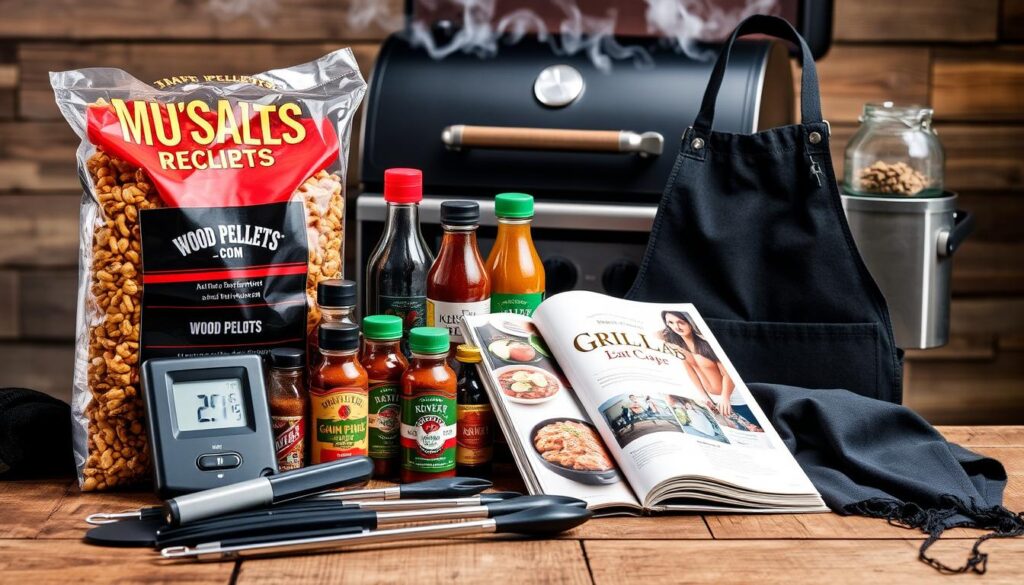
Customized Aprons and Cooking Gear
A personalized apron or chef’s hat is a cool gift for grill masters. Custom aprons protect clothes and show you care. Choose ones made from quality materials that last through many uses and washes.
High-Quality Utensils and Tools
For serious grillers, the right tools are essential. Look for grilling sets made from durable materials like stainless steel. A good set includes tongs, spatulas, and brushes. These tools make grilling easier and better, making them great gifts.
Budget-Friendly Gifts for Pellet Grill Aficionados
Pellet grilling doesn’t have to cost a lot when you’re looking for gifts. I’ve put together a list of affordable gifts for pellet grill fans. These ideas are all under $50, making them great for any event.
Affordable Yet Practical Accessories
Looking for gifts that won’t break the bank? Practical accessories are a great choice. Grill gloves, meat thermometers, and grill brushes are must-haves that are easy on the wallet. They make grilling safer and more efficient.
Gifts Under $50
I’ve gathered some top gift ideas for pellet grill enthusiasts that won’t cost much. You can find durable grill tools or a variety pack of wood pellets. These gifts are sure to make any pellet grill lover happy.
| Gift Item | Description | Price |
|---|---|---|
| BBQ Grill Gloves | Heat resistant and flexible for dexterity | $20 |
| Digital Meat Thermometer | Ensures perfect cooking every time | $30 |
| Stainless Steel Grill Brush | Durable and effective for grill maintenance | $15 |
| Variety Pack of Wood Pellets | Enhances flavor with different wood types | $25 |
Luxury Gifts for Pellet Grill Connoisseurs
Looking to impress a grill enthusiast? The right luxury gift can make a big difference. These high-end options combine top performance with stunning design. They promise to take any grilling experience to new levels.

Premium Pellet Grill Models
Investing in top-tier pellet grill models is a great way to impress. These grills have advanced features, strong build, and look great. Brands like Traeger and Yoder Smokers are favorites, with WiFire technology for remote control and precise temperature settings.
Top-of-the-Line Grilling Gadgets
For the ultimate gifts for pellet smoking aficionados, consider premium grilling gadgets. Look for smart thermometers and tools with the latest tech. They ensure precision and ease, like the MEATER+ wireless meat thermometer or the Flame Boss temperature controller.
Choosing these premium options means you’re giving the best gifts for pellet smoking fans. They’ll have an amazing grilling experience.
Outdoor Cooking Gifts for Pellet Grill Lovers
For those who love outdoor cooking, finding the right gift for their pellet grill is key. It can make their grilling time even better. There are many great options, from portable cooking stations to tough, weather-proof covers.
Portable Cooking Stations
Portable cooking stations are great for those who grill on the go. They have lots of space for prep, storage, and even tool hooks. Brands like FireBoard and GrillGrate make stations that work well with pellet grills, adding ease and function.
Weather-Resistant Grilling Covers
Keeping your pellet grill safe from the weather is important. That’s why weather-resistant covers are a smart choice. They protect against rain, snow, and UV rays, helping your grill last longer. BBQr’s Delight and PEACHY’S offer some of the best covers, perfect for any pellet grill owner.
Customized Gifts for Pellet Grilling
Customized gifts for pellet grilling make any grilling session special. They show off personality and taste. These gifts turn a simple grilling session into a memorable event.
Engraved Tools and Accessories
Engraved tools and accessories are a hit with pellet grilling fans. They can have names, dates, or quotes that mean a lot. Items like engraved spatulas, tongs, and cutting boards add a personal touch.
Personalized Recipe Cards and Cookbooks
Personalized recipe cards and cookbooks are also great gifts. Imagine getting a set of recipes made just for your pellet grill. These gifts are both useful and show you care about their cooking interests. Cookbooks can hold family recipes, favorite dishes, or space for new ones.
Subscription Services for Pellet Grillers
Subscription services for pellet grillers are a great way to keep grilling exciting. They send monthly deliveries of spices, rubs, and grilling essentials right to your door. This is perfect for those always looking for new flavors and techniques.
Monthly Spice and Rub Deliveries
Imagine getting a new package every month with exotic spices and unique rubs for pellet grilling. These deliveries are great gifts for pellet grilling fans because they bring new flavors every month. You might get a sweet and smoky BBQ rub from Memphis or a spicy Jamaican jerk seasoning. These surprises make every grilling session better.
Exclusive Memberships for Grilling Communities
Subscription services also offer memberships to exclusive grilling communities. These memberships give you access to online forums, recipe clubs, and virtual grill-alongs. It’s a great way for enthusiasts to share their passion and learn from others.
| Service | Benefits |
|---|---|
| Grill Masters Club | Monthly rubs and sauces, exclusive recipes, online community access |
| BBQ Box | Hand-selected spices, grilling accessories, curated recipes |
| The Flavor Fix | Custom spice blends, cooking tips, subscription flexibility |
Holiday-Themed Gifts for Pellet Grill Users
The holiday season is a great time to get the pellet grill lover in your life something special. These holiday-themed gifts for pellet grill users bring joy and are very useful. They mix the holiday spirit with the love of grilling.
Seasonal Tool Sets
A top must-have gift for pellet grill users is a seasonal tool set. These sets have festive designs for holidays like Christmas, Halloween, or Thanksgiving. Tools like Christmas spatulas, Halloween tongs, or Thanksgiving basting brushes make grilling fun and add holiday cheer.
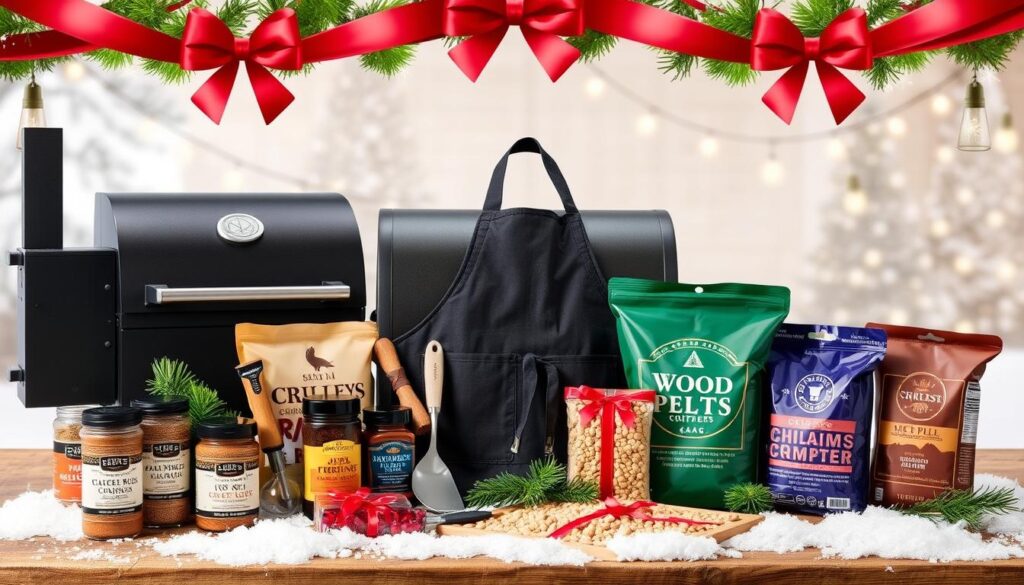
Festive Grilling Accessories
Other holiday-themed gifts for pellet grill users include festive accessories. Think about grill mats with holiday designs, LED grill lights in holiday shapes, or themed aprons and oven mitts. These gifts are useful and make grilling more enjoyable.
Conclusion
Choosing the right gift for pellet grill owners can really make their grilling better. You can find everything from meat thermometers and grilling tools to rib racks and smoker tubes. Each item adds something special to their cooking.
Wondering what is a good gift for a pellet grill? Go for practical and quality items. They are always a safe choice.
It’s not just about the gift, but the thought behind it. Personalized gifts like engraved tools or recipe books show you care. High-tech items like smart thermometers bring new ideas to their cooking. And, there are affordable options too, so you can find something special without spending a lot.
The goal is to find gifts that will be loved and used often. Whether it’s something they need or a luxury they want, your choice will bring happiness. So, pick a gift that not only enhances their grilling but also shows you care, making it a truly special present.
FAQ
What is a good gift that will be used with a pellet grill?
A good gift for a pellet grill user should make grilling better. Think about high-quality wood pellets, a smart thermometer, or a durable grill cover. These items are useful and show you care about their grilling hobby.
What are the best gifts for pellet grill owners?
The best gifts for pellet grill owners are tools and accessories that make grilling easier. Look into premium grill tools, high-tech thermometers, and weather-resistant covers. These are always a hit.
What are some unique gifts for pellet barbecue lovers?
Unique gifts for pellet barbecue lovers include personalized BBQ tools and exclusive recipe books. Handcrafted marinades and rubs are also great. These gifts show you’ve thought about their grilling passion.
What are the top gift ideas for pellet grilling enthusiasts?
Top gift ideas for pellet grilling enthusiasts include high-end gadgets and premium wood pellets. Subscription services for spices and rubs are also great. These gifts offer both practicality and luxury.
What are the must-have gifts for pellet grill users?
Must-have gifts for pellet grill users include essential tools like grill brushes and spatulas. Safety accessories like heat-resistant gloves and aprons are also important. These items make grilling safer and more efficient.
What are the top-rated pellet grill gift suggestions?
Top-rated pellet grill gift suggestions include Wi-Fi-enabled thermometers and Bluetooth speakers. High-quality grill lights for nighttime grilling are also great. These gifts add tech and convenience to grilling.
What ultimate gifts would delight pellet smoking aficionados?
Ultimate gifts for pellet smoking aficionados include luxury items like premium pellet grill models. Top-tier grilling gadgets and exclusive memberships to grilling clubs are also impressive. These gifts aim to elevate the grilling experience.
What are the best gifts for pellet grilling enthusiasts?
The best gifts for pellet grilling enthusiasts enhance their setup and enjoyment. Consider gifting custom engraved tools, high-quality wood pellet assortments, or smart home-compatible grilling devices. These gifts show you value their grilling passion.
What are some great gift ideas for pellet grill masters?
Great gift ideas for pellet grill masters include high-quality utensils and tools. Customized aprons and cooking gear, along with professional-grade grill accessories, are also excellent. These gifts support their mastery and dedication.
grilling-on-a-pellet-grill-your-questions-answered
Are you curious about pellet grills and how they can enhance your backyard barbecues? You’re in the right place! This guide will cover everything you need to know about pellet grilling. We’ll answer your questions and help you become a pro at this cooking method.
From the science behind pellet smokers to mastering delicious techniques, we’ve got you covered. Get ready to explore the world of pellet grilling.
Key Takeaways
- Pellet grills offer precise temperature control for both slow cooking and fast searing.
- Different wood pellet flavors can impart unique and delicious taste profiles to your grilled creations.
- Pellet grills require less maintenance compared to traditional charcoal and gas grills.
- Pellet grills are gaining mainstream popularity as a versatile cooking solution.
- Choosing high-quality pellets is crucial for optimal flavor and burn efficiency.
Understanding How Pellet Grills Work
Pellet grills are gaining popularity fast. They offer a unique way to grill, smoke, and cook many foods. To get how they work, let’s look at their parts and the science of pellet smoking.
Components of a Pellet Grill
A pellet grill has a hopper, an auger, a burn pot, a heating element, a fan, and a digital controller. The hopper stores wood pellets. The auger feeds them into the burn pot. The heating element lights them, and the fan spreads the heat and smoke evenly.
The Science Behind Pellet Smoking
The pellet smoking process is designed for great taste and consistency. It uses the auger to feed pellets into the burn pot. There, they burn, and the fan spreads the smoke and heat. This infuses food with a deep, smoky flavor.
Digital Control Systems
Pellet grills have advanced digital temperature control. They keep the cooking temperature just right. This is thanks to sensors that adjust the auger and fan. It’s like having an indoor oven outdoors.
“Investing in a Yoder Smokers S-Series pellet grill ensures delicious outdoor meals and lasting memories.”
Pellet grills are innovative and easy to use. They make grilling fun and help you cook amazing dishes.
How Do You Grill on a Pellet Grill: Step-by-Step Guide
Learning to grill on a pellet grill is simple once you know the basics. Whether you’re an experienced griller or new to pellet grill cooking, this guide will help you cook like a pro quickly.
- First, make sure your pellet grill is plugged in and the hopper is full of quality wood pellets. A typical pellet grill uses 1-3 pounds of pellets per hour, based on the cooking temperature.
- Turn the grill on to “Smoke” or “On” with the lid open. Wait about 5 minutes for steady smoke to appear. This step is key for even cooking and a temperature of 225-250°F.
- After preheating, close the lid and set your cooking temperature. Pellet grills let you control the temperature precisely, for perfect sears or slow-smoked flavors.
- Put your food on the grates and cook as the recipe says. Pellet grills can smoke, grill, roast, and even bake many dishes.
- Use a digital probe thermometer to check your food’s internal temperature. This ensures your dishes are cooked just right, whether it’s steak, brisket, or chicken.
- When you’re done cooking, follow the maker’s guide to safely turn off your pellet grill for upkeep.
The secret to great pellet grill cooking is patience, careful attention, and a desire to try new things. With some practice, you’ll grill like a pro and enjoy the tasty, wood-fired flavors of your pellet grill.
Benefits of Cooking with a Pellet Grill
Pellet grills are a hit among outdoor cooking fans. They stand out for their temperature control precision. These grills keep temperatures steady, often just 5°F off the target, in the 350°F–425°F range. This means your meals are always perfectly cooked.
They also bring a unique flavor enhancement. Using different wood pellets, you can add a wonderful, wood-fired flavor to your food. You can choose from smoky hickory to sweet apple, making every dish special.
Pellet grills are also super convenient. They have digital controls and let you set specific temperatures. This means you can just set it and forget it, letting the grill cook while you do other things. They’re perfect for slow cooking, like smoking brisket or ribs.
“Pellet grills significantly reduce the steps required during cooking compared to charcoal smokers, making them a more convenient option for outdoor enthusiasts.”
Moreover, pellet grills are versatile. They can grill, smoke, and even bake cookies, pies, and more. This makes them a great investment for anyone looking to try new recipes.
Even though pellet grills are pricier than gas or charcoal grills, their benefits are worth it. They offer temperature precision, flavor enhancement, and convenience. For those who love great outdoor cooking, pellet grills are a top choice.
Essential Temperature Guidelines for Different Foods
Grilling on a pellet grill needs the right temperature for perfect food. The pellet grill temperature guide changes with the food type. Knowing the best smoking and grilling temperatures is key.
For general barbecue smoking, aim for 225-250°F. Pork shoulder cooks best at 220-230°F. Brisket does well at 225°F or lower. Poultry should be smoked at 250-300°F.
For hot and fast cooking, use 400-500°F. Most pellet grills can go up to 750°F. Always check recipes and use a meat thermometer for safety and doneness.
| Food | Ideal Grill Temperature | Ideal Internal Temperature |
|---|---|---|
| Steak | High heat (450-650°F) | Extra rare (115-120°F), Rare (125-130°F), Medium-rare (130-140°F), Medium (140-150°F), Medium-well (150-155°F), Well-done (160+°F) |
| Chicken | 350-450°F | 165°F (whole chicken: 180°F) |
| Hamburgers | 400°F | 160°F |
| Fish | 375-700°F (depending on type) | 145°F (shrimp: 120°F) |
Remember, smoking and grilling temperatures change with food type and desired doneness. Always use a meat thermometer for perfect and safe dishes.
Choosing the Right Wood Pellets for Your Grill
Grilling on a pellet grill is all about the wood pellets you choose. They can make your food taste amazing, from smoky to fruity. The right wood pellet flavors can take your cooking to the next level.
Popular Wood Flavors
- Oak: Versatile and complements beef and seafood.
- Maple: Mild and pairs well with pork and poultry.
- Hickory: Robust smoky flavor that enhances beef and pork.
- Mesquite: Strong flavor, favored for brisket in Texas.
- Cherry: Sweet smoky flavor that complements pork.
- Apple: Fruity smoke that enhances poultry and pork.
- Alder: Versatile smoky flavor that pairs well with various meats.
- Pecan: Nutty and sometimes spicy, great with beef, pork, and baked goods.
Pellet Quality Factors
Choose pellet quality wisely for your grill. Look for 100% hardwood pellets without additives. Brands like Traeger and Camp Chef BBQ Pellets are top-notch. They ensure a clean burn and great taste. Stay away from softwood pellets, as they can ruin the flavor.
Storage Requirements
Keeping your pellet storage right is key. Store them in a sealed container or bag in a cool, dry spot. This keeps them fresh and prevents moisture damage. Moisture can mess with their burn and taste.
“Experimenting with different wood pellet flavors is part of the fun of using a pellet grill. Discover your favorite combinations to create truly unique and delicious grilled dishes.”
Understanding wood pellet flavors, pellet quality, and pellet storage unlocks your pellet grill’s full potential. You’ll be able to make meals that wow everyone.
Maintenance and Cleaning Tips
Keeping your pellet grill in good shape is key to its long life and best performance. How often you clean it depends on how much you grill. But, aim to deep-clean it every 5-10 times you use it, based on ash buildup.
First, clean the grates after each use. Use a nylon brush or crumpled foil to get rid of food and grease. For a deeper clean, you can wash the grates in the dishwasher. Don’t forget to clean the thermometer and grease chute to avoid fires.
- Empty the ash from the fire pot and igniter after every other use.
- Regularly inspect and clean the auger and fan to maintain efficient airflow.
- Use a wet/dry vacuum to clean out any residual buildup from the interior of the grill.
- Clean the exterior of the grill with a degreaser or stainless steel cleaner to keep it looking its best.
For longer smoking sessions, you might need to clean the grill more often. By following these tips, you can make your pellet grill last longer. This way, you can enjoy great, smoky meals for years.
“Proper maintenance ensures optimal performance and longevity of your pellet grill.”
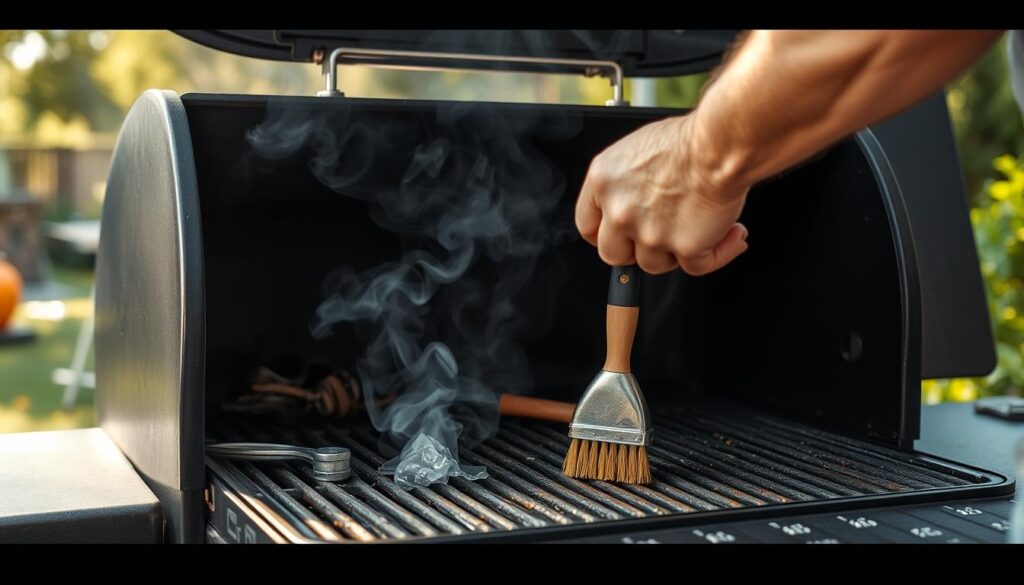
A well-kept pellet grill will grill better and give you a better grilling experience. Take the time to clean and maintain it. You’ll get delicious, evenly cooked meals every time.
Pellet Grill Cooking Techniques
Pellet grills are versatile, letting you try different cooking methods. You can do pellet grill smoking and searing on a pellet grill. These grills can help you improve your grilling skills.
Direct vs Indirect Grilling
Pellet grills work for both direct and indirect grilling. For direct grilling, place food right over the fire pot. This method gets your food hot and browned quickly. Many grills can get over 500°F, perfect for this.
For indirect grilling, put food away from the heat. It cooks like an oven, slowly and gently.
Smoking Methods
Pellet grills are great for pellet grill smoking. They let you add smoky flavors to your food. Start at 225-250°F and let it smoke for hours.
As the temperature goes up, the smoke might lessen. So, try different temperatures to get the smokiness you like.
Searing Capabilities
Some pellet grills have trouble with high-heat searing. But, many new models can get hot enough. Look for ones that can go over 500°F. This way, you can sear on a pellet grill and get a great crust on your meat.
Try out all the cooking techniques with your pellet grill. Don’t be shy to experiment. Find what works best for your grill and your taste.
Common Pellet Grilling Mistakes to Avoid
Pellet grilling is a tasty way to cook, but even pros can slip up. To get great results, steer clear of these common mistakes:
- Don’t add wood chips to the hopper or fire pot. Pellet grills are made for wood pellets. Chips can mess with airflow and temperature.
- Keep the vents open. Good airflow is key for your pellet grill to work right. Closed vents can cause uneven cooking.
- Always start with the lid open. Closing it too soon can lead to temperature spikes and uneven heating.
- Resist the urge to frequently open the lid during cooking. This can drop the temperature a lot, messing with your cooking.
Proper maintenance is also crucial. Make sure to:
- Clean the grill often, including the grease bucket and diffuser, to avoid buildup and fire risks.
- Use quality cleaning products and disposable bucket liners for easy cleanup.
- Store your pellets in a dry, airtight container to prevent moisture absorption, which can affect their performance.
Remember, weather can affect your grill. Watch how temperature, wind, and humidity change your cooking, and adjust your methods.
Avoiding these mistakes will help you get better at pellet grilling. You’ll enjoy tasty, consistent results every time you grill.
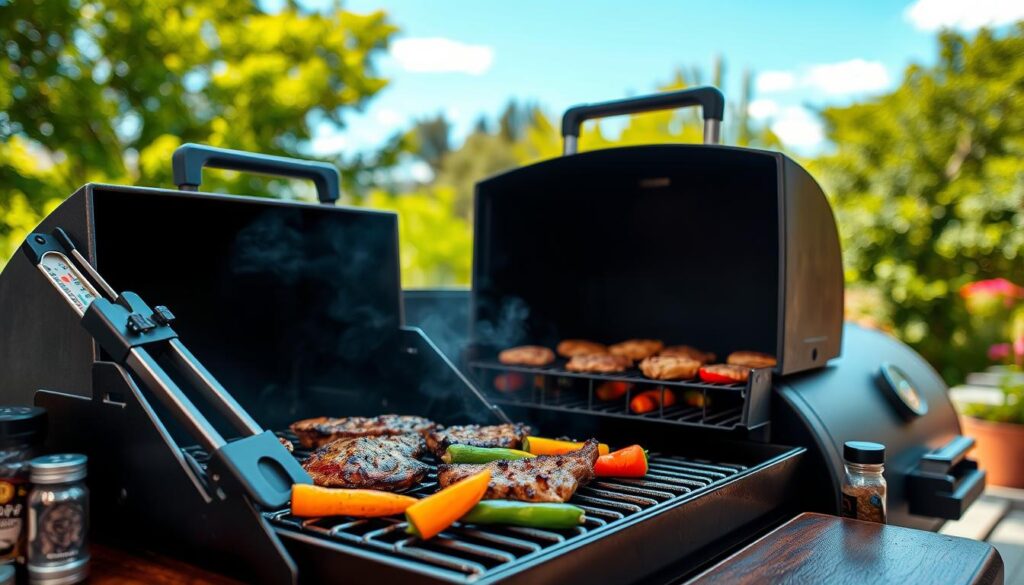
| Mistake | Explanation | Tip |
|---|---|---|
| Adding wood chips | Disrupts airflow and temperature control | Use only wood pellets designed for pellet grills |
| Closing the vents | Reduces proper airflow, leading to temperature fluctuations | Keep the vents open for consistent cooking |
| Closing the lid before preheating | Can cause temperature spikes and uneven heating | Always start with the lid open during the preheating process |
| Frequently opening the lid | Causes significant temperature drops, affecting the cooking process | Resist the urge to open the lid too often to maintain consistent temperatures |
| Neglecting cleaning and maintenance | Leads to grease buildup and potential fire hazards | Clean the grill regularly, including the grease bucket and diffuser |
| Improper pellet storage | Moisture absorption can affect pellet performance | Store pellets in a dry, airtight container |
By avoiding these common pellet grill tips, grilling errors, and pellet smoking mistakes, you’ll master pellet grilling. Enjoy delicious results every time.
Comparing Pellet Grills to Traditional Grilling Methods
Pellet vs Gas
The debate between pellet grills and gas grills centers on flavor. Pellet grills give food a wood-fired taste, unlike gas grills’ neutral flavors. Yet, gas grills can heat up faster for searing and getting that perfect char.
Pellet vs Charcoal
Pellet grills beat charcoal grills in temperature control. They have digital controllers for easy temperature setting, unlike charcoal grills’ need for constant fire management. Pellet grills also leave less ash, making grilling cleaner. But, charcoal grills offer a smoky flavor that some love.
Choosing between pellet, gas, and charcoal grills depends on your preferences and grilling needs. Pellet grills mix wood-fired taste, precise temperature control, and versatility. They’re a great choice for today’s grilling fans.
FAQ
What are the key components of a pellet grill?
A pellet grill has a hopper, auger, burn pot, heating element, fan, and digital controller. The auger feeds pellets into the burn pot for ignition. A fan spreads the heat, and the digital controller controls the temperature.
How do you start and operate a pellet grill?
First, plug in the grill and fill the hopper. Turn it on until you see smoke. Close the lid and set the temperature. It takes about 5 minutes to preheat, then you can cook your food.
What are the benefits of cooking with a pellet grill?
Pellet grills offer precise temperature control and versatility. They are easy to use and provide consistent results. You can customize flavors with different wood pellets and they use indirect heat to reduce flare-ups.
What are the recommended temperature ranges for different cooking techniques?
For BBQ smoking, use 225-250°F. Pork shoulder is best at 220-230°F, and brisket at 225°F or lower. Poultry smokes well at 250-300°F. For fast cooks, temperatures can be 400-500°F. Most pellet grills can go up to 750°F.
How do you choose the right wood pellets for your grill?
Pick pellets based on the meat and flavor you want. Hickory, oak, mesquite, maple, and apple are popular. Use high-quality pellets with less than 6% moisture for efficient burning. Try different brands and types to find your favorite flavors.
What are the essential maintenance and cleaning tasks for a pellet grill?
Clean your pellet grill every 5-10 uses, depending on ash buildup. Clean the grates after each use and the fire pot and igniter after every other use. Regularly check and clean the auger and fan. This keeps your grill working well for a long time.
Can pellet grills handle different cooking techniques?
Yes, pellet grills can do smoking, roasting, and baking. For smoking, use 225-250°F for a long time. Direct grilling is possible at 550°F+ on some models. Try different techniques to use your grill to the fullest.
What are some common mistakes to avoid when using a pellet grill?
Don’t put wood chips in the hopper or fire pot. Keep vents open for airflow. Start with the lid open and avoid opening it too much during cooking. Clean and maintain your grill, and store pellets properly to prevent moisture.
How do pellet grills compare to traditional grilling methods?
Pellet grills offer more flavor than gas grills but less than charcoal. They have better temperature control than charcoal but may not get as hot as gas grills. Pellet grills are easier to use than charcoal and produce less ash. They combine the best of smokers, charcoal, gas, and ovens, offering versatility.
How to Host a Backyard BBQ Practice Session for Competition Prep
Are you dreaming of being a top barbecue competitor? Want to improve your grilling skills and wow the judges at your next event? The key to success might be in your own backyard. A backyard BBQ practice session can help you sharpen your skills, try out new flavors, and get ready for the big competition.
Key Takeaways
- Hosting a backyard BBQ practice session is crucial for perfecting your competition-level skills.
- Recreate the competition environment in your own backyard to test your meat preparation, smoke management, and workflow strategies.
- Experiment with different seasonings, rubs, and cooking methods to find your signature flavors.
- Develop a detailed timeline and coordinated approach to tackle multiple meat categories simultaneously.
- Prioritize food safety and cleanliness to ensure your practice sessions are safe and effective.
What Is a Backyard BBQ Practice Session?
Perfecting your barbecue skills takes time, dedication, and lots of practice. That’s what a backyard BBQ practice session is for. It lets you practice like you’re in a real competition BBQ event at home. This way, you can work on your BBQ competition preparation and BBQ technique before the judges see your work.
Preparing for Competitive Barbecue Events
Competitive barbecue is serious business, where every detail matters. A mock backyard BBQ practice session lets you try out different meat prep methods, rubs, and sauces. It also helps you work on your timing and how you work. This is key to spotting and fixing any weak spots in your skills before the big day.
Importance of Practice and Refinement
- Regular backyard BBQ practice sessions help you get better at making your dishes look great. This shows off your cooking skills.
- Practicing at home helps you learn how to control the heat and air flow. This is key for making perfect food every time.
- By trying different BBQ competition preparation methods, you can improve your skills. Keep trying until you’re a pro at competition-level barbecue.
“The only way to get better at competition barbecue is to practice, practice, practice. The backyard is the perfect place to hone your skills and prepare for the big stage.”
Using the backyard BBQ practice session can really help you do well in competitions. Make the most of this chance to improve your skills and you’ll see your abilities grow.
Essential Gear for BBQ Practice Sessions
Getting ready for a backyard BBQ practice session means having the right gear. High-quality BBQ competition gear, backyard BBQ tools, and grilling accessories make the practice fun and help you get ready for real competitions.
A durable and reliable grill or smoker is key for a BBQ practice. Choose one with precise temperature control and enough space to cook like in a real competition. Also, get heat-resistant gloves to keep your hands safe while cooking.
- High-quality grill or smoker
- Heat-resistant gloves
- Meat thermometers
- Prep surfaces and cutting boards
- Storage containers for ingredients and prepped meats
Make sure you have meat thermometers to cook your proteins just right. Prep surfaces and cutting boards are great for trimming and seasoning meats. And, use storage containers to keep your ingredients and meats ready to go.
| Gear Item | Purpose | Key Features |
|---|---|---|
| Grill or Smoker | Cooking the meat | Precise temperature control, ample cooking space |
| Heat-Resistant Gloves | Protecting your hands | Durable, heat-resistant material |
| Meat Thermometer | Ensuring proper doneness | Accurate temperature readings |
| Prep Surfaces | Trimming and seasoning meats | Sturdy, easy-to-clean surfaces |
| Storage Containers | Organizing ingredients and prepped meats | Airtight, leak-proof containers |
With the right BBQ competition gear, backyard BBQ tools, and grilling accessories, your practice sessions will feel like real competitions. This helps you improve your skills and get ready for success.
Creating a Mock Competition Environment
To make the most of your backyard BBQ practice, set up a mock competition area. This means creating a backyard BBQ cook site that mirrors a real competition. Use the same equipment and space limits you’ll face at a BBQ event.
Setting Up a Backyard Cook Site
When setting up your backyard BBQ cook site, try to make it as similar to a real competition setup as you can. This includes:
- Choosing a specific cooking area with limited space, just like at a BBQ competition
- Using the same smokers, grills, and equipment you’ll use in the competition
- Setting up your prep and serving tables to match the competition layout
Simulating Competition Conditions
It’s not just about the setup. You also need to simulate competition conditions. This means:
- Following strict time limits for each part of your BBQ practice session
- Dealing with weather issues like wind, rain, or extreme temperatures
- Preparing multiple meat categories at once, just as in a competition
By setting up a realistic competition-style BBQ setup at home, you can practice and improve your skills. This ensures you’re ready for the real competition.
Mastering Meat Preparation Techniques
To win at BBQ, you need to master meat prep. Practice at home to get good at trimming and seasoning meats. Try different rubs, marinades, and cooking ways to find what works best.
Trimming and Seasoning Meats
Start by trimming the fat and connective tissue from your meats. This makes your BBQ look and taste better. Then, season your meat with spices, herbs, and marinades to get that competition-worthy BBQ taste.
Achieving the Perfect Bite
The “perfect bite” in BBQ is tender yet not overcooked. It should pull apart easily. Practice at home to get the texture and flavor right by adjusting your cooking.
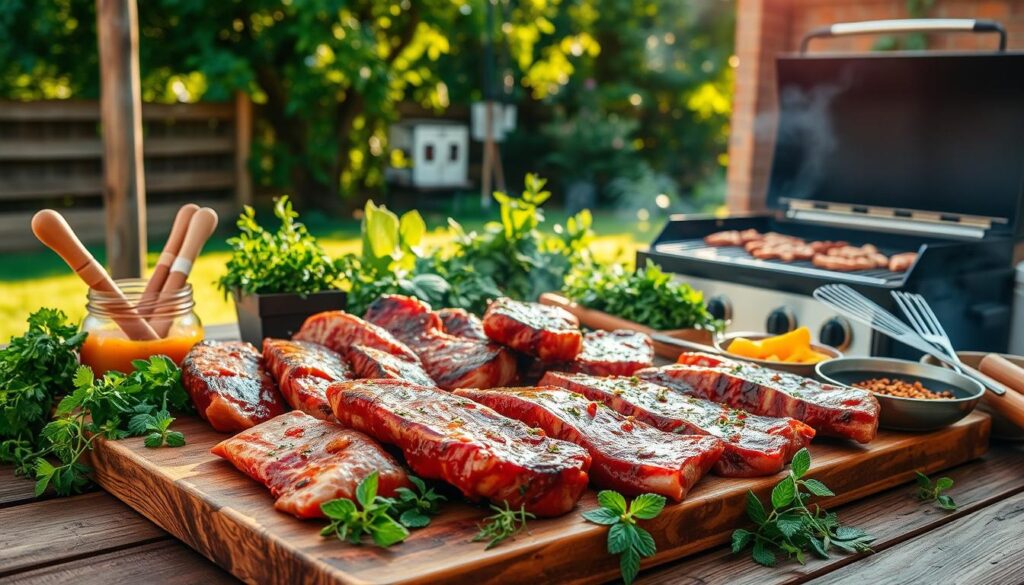
“The secret to a mouthwatering BBQ dish is in the careful preparation of the meat. Perfecting your trimming and seasoning techniques is crucial for success in any competitive event.”
| Meat Preparation Technique | Benefits |
|---|---|
| Precise Trimming | Enhances appearance and texture |
| Flavorful Seasoning | Adds depth and complexity to the flavor profile |
| Achieving the Perfect Bite | Ensures a tender and delectable eating experience |
Smoke and Fire Management
Learning how to control smoke and fire is key in competitive barbecue. Practice at home to get better at managing your cooking setup’s temperature and airflow. Try different woods, adjust your vents, and watch the meat’s temperature to get tasty and ready-for-competition results.
Controlling Temperature and Airflow
Getting your grill to the right temperature is key for delicious, tender barbecue. Try out various woods like oak, cherry, or apple to find the best smoke flavor and heat. Keep an eye on your meat’s temperature and tweak the airflow and dampers to stay within your desired range.
- Experiment with different wood types to find the ideal smoke flavor
- Adjust your dampers and vents to regulate airflow and temperature
- Closely monitor the internal temperature of your meats
Good airflow is also vital for top-notch barbecue. Make sure your setup lets smoke and heat move freely around your meats. By getting the hang of controlling temperature and airflow, you’ll make barbecue that’s tender, juicy, and smoky to perfection.
“The secret to great barbecue lies in the perfect balance of smoke, fire, and temperature.”
Timing and Workflow Strategies
Winning BBQ competitions is all about perfect timing and managing your workflow well. In your practice BBQs, make a detailed plan for each meat type. Start with the end time and work your way back. This ensures every dish is perfect for the judges.
Developing a Cooking Timeline
First, know the turn-in times for each meat in your competition. Then, plan your cooking timeline from the end, including prep, cooking, and resting times. This keeps you on schedule and avoids last-minute stress.
Coordinating Multiple Meat Categories
BBQ competitions often have many meats like chicken, ribs, pork, and brisket. Practice managing these meats together during your BBQs. This way, each dish will be ready and perfect for the judges.
| Meat Category | Prep Time | Cook Time | Rest Time | Total Time |
|---|---|---|---|---|
| Chicken | 30 minutes | 1 hour | 15 minutes | 1 hour 45 minutes |
| Ribs | 45 minutes | 2 hours | 20 minutes | 3 hours 5 minutes |
| Pork | 1 hour | 3 hours | 30 minutes | 4 hours 30 minutes |
| Brisket | 1 hour | 5 hours | 45 minutes | 6 hours 45 minutes |
By perfecting your BBQ competition timing and cooking workflow in practice, you’ll master coordinating multiple meats and preparing for your competition.
Backyard BBQ practice session
Hosting a backyard BBQ practice session is a smart move for your BBQ career. It lets you test and improve your skills, try new flavors, and find what needs work before a real event. Doing this often will boost your confidence and sharpen your skills for competition BBQ preparation.
To make the most of your outdoor cooking practice, follow these steps:
- Set up your backyard BBQ area like a real competition setup, with space for your smoker, prep area, and turn-in boxes.
- Simulate the time pressure of a real competition by sticking to a tight cooking schedule during your practice.
- Try out different BBQ technique improvement ideas, like new rubs, sauces, or cooking ways, to see what suits you best.
- Get feedback from friends or family on the taste, look, and quality of your dishes, just like the judges would.
- Keep detailed notes on what worked well and what didn’t, and use this info to get better for the next practice.
Regular backyard BBQ practice will help you get better at competitive BBQ and reach your cooking goals.
| Key Benefits of Backyard BBQ Practice Sessions | Potential Challenges to Consider |
|---|---|
|
|
By using backyard BBQ practice, you’ll get closer to being a pro at competitive BBQ and reaching your cooking dreams.
Presentation and Garnishing Tips
In the world of competitive BBQ, how your turn-in boxes look can make a big difference. During practice at home, work on making your meats look amazing. This will help you impress the judges.
Creating Visually Appealing Turn-In Boxes
How you present your BBQ is as important as the taste. Try different garnishes and ways to arrange your food. This will make your dish look great and true to BBQ competition standards. Learning how to garnish your turn-in boxes well shows off your cooking skills.
To make your BBQ look better, follow these tips:
- Carefully trim and prepare your meats to show off their beauty.
- Arrange your proteins, sauces, and garnishes in a way that looks good together.
- Add colors like fresh herbs, bright sauces, or creative garnishes.
- Try to make your box look balanced and symmetrical for a professional look.
- Practice your presentation at home to get better scores in competitions.
Getting good at presenting your turn-in boxes can really help you in BBQ competitions. Remember, how your food looks is just as important as how it tastes. Spend time making your BBQ presentation perfect during practice at home.
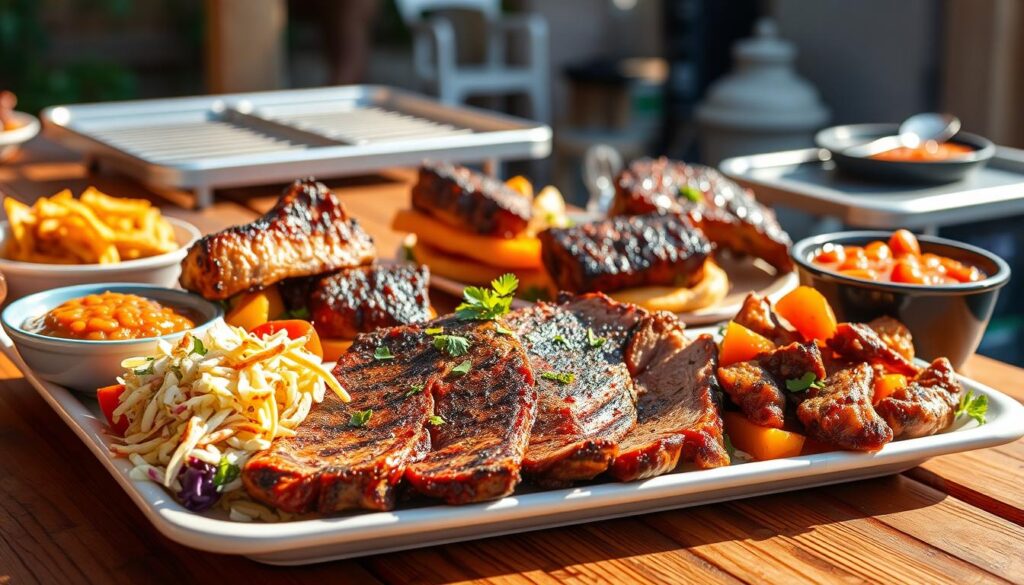
Food Safety Practices
Hosting a successful backyard BBQ practice session means paying close attention to food safety. As a seasoned pit master, you know how important it is to keep food at the right temperatures. You also need to follow strict sanitation rules and handle food like a pro. These steps keep your dishes safe and show you care about food safety, which is key for the judges.
Maintaining Proper Food Temperatures
It’s vital to cook meats to the right internal temperatures for safety and flavor. Use a digital food thermometer to check the temperature of your meat while it cooks. Keep hot foods hot and cold foods cold. Know the USDA’s safe minimum temperatures for different meats to follow top food safety standards.
Sanitation and Cleanliness
Keeping your BBQ area clean is crucial for success. Clean and disinfect all surfaces, utensils, and gear before and during your practice. Wash your hands often and think about using disposable gloves to avoid contamination. Clean work areas and throw away trash properly to follow strict BBQ food safety rules.
By focusing on food safety at your BBQ practice, you keep your guests safe and show you’re serious about competitive BBQ. Keeping temperatures right, staying clean, and handling food like a pro will make you stand out. It will also help you do well in competitions.
Analyzing Results and Making Adjustments
After each backyard BBQ practice, it’s key to analyze your results and use any feedback or lessons learned. Check your scores and comments to see where you did great and where you can get better. Look at improving your competitive barbecue skills. Use this info to improve your techniques, change your strategies, and get ready for future BBQ events.
Reviewing Scores and Feedback
Look over the scores and feedback from your practice BBQs. Find patterns or areas where you do well or struggle. Pay attention to what the judges say. They offer great tips on what you’re doing right and where you can get better.
Refining Your Techniques
After reviewing your results and feedback, pinpoint what needs work in your cooking. This could be how you prepare meat, manage smoke and fire, plan your timing, or how you present your food. Try new methods, collect data, and keep tweaking your skills until you hit your goals.
Remember, doing well in competitive BBQ means always getting better. By looking at your practice results, using feedback, and improving your skills, you’ll do better in future BBQ events.
“The true path to excellence in competitive barbecue is paved with a relentless pursuit of improvement. Every practice session is an opportunity to learn, grow, and refine your craft.”
Conclusion
Hosting a backyard BBQ practice session is key to improving your competitive barbecue skills. It lets you perfect your techniques, try new flavors, and get better before the judges. With regular practice and a focus on details, you can do better in competitive BBQ events.
Mastering backyard BBQ is crucial for winning competitions. You’ll learn a lot, improve how you prepare meat, and get better at controlling smoke and fire. Every practice makes you more confident and helps you get your timing right. You’ll also learn how to present your BBQ in a way that wows everyone.
The path to winning BBQ competitions starts at home. Use this chance to try new things, push your BBQ skills, and get ready for the big event. By working hard and enjoying the process, you’ll soon be among the top BBQ champions.
FAQ
What is the purpose of hosting a backyard BBQ practice session?
Hosting a backyard BBQ practice session is key to getting ready for BBQ competitions. It lets you practice in your own space, perfect your skills, and try out new flavors. This way, you’re ready for judges when the time comes.
What type of gear is recommended for a successful backyard BBQ practice session?
For a great BBQ practice, you need top-notch grills or smokers, heat-resistant gloves, and meat thermometers. Also, prep surfaces and storage containers are a must. The right gear makes your practice feel like the real thing.
How can I create a mock competition environment in my backyard?
Set up a cook area in your backyard that mirrors the real competition setup. Use the same equipment and space you’d find at an event. Try to mimic the competition by sticking to time limits, handling weather, and prepping different meats at once.
What are some tips for mastering meat preparation techniques for competition?
Work on trimming and seasoning meats to get the flavor and texture you want. Try different rubs and marinades to find what the judges like. Aim for that perfect bite where meat comes off easily without being overcooked.
How can I improve my smoke and fire management skills during a backyard BBQ practice session?
Improve your control over temperature and airflow in your cooking area. Play with different woods, adjust your damper settings, and check meat temperatures for consistent flavor.
What are some strategies for effective timing and workflow management during a backyard BBQ practice session?
Create a detailed timeline for each meat type, starting with the end time and working back. Practice prepping several meats at once to ensure they’re all perfect for the judges.
How can I improve the presentation of my turn-in boxes during a backyard BBQ practice session?
Focus on making your turn-in boxes look great. Try different garnishes and layouts to make your meats stand out. This will make your dishes both tasty and visually appealing.
What food safety practices should I implement during a backyard BBQ practice session?
Keep your food at safe temperatures and handle it safely. Make sure your cooking area is clean. This keeps your food safe and shows you care about quality, which judges will notice.
How can I analyze the results and make adjustments after a backyard BBQ practice session?
Look over your scores and feedback after each practice. See what you did well and what needs work. Use this info to improve your skills and strategies for the next competition.
Tips for Smoking Meat in Different Weather Conditions
Smoking meat is a joy that you can enjoy all year round. It lets you enjoy tasty, smoky flavors, no matter the weather. But, you need to adjust your smoking ways for different climates. We’ll share expert tips and strategies to help you smoke meat in any weather, from cold winters to hot summers.
You’ll learn how to keep temperatures steady, manage fuel, and smoke safely outside. This way, you can make delicious meat, even when it’s snowing, raining, or very hot.
Are you ready to improve your outdoor smoking skills, no matter the weather? Learn the secrets to making perfect smoked meat, even when the weather is unpredictable.
Key Takeaways
- Adapt your smoking techniques to handle various weather conditions, from cold to hot and everything in between.
- Learn how to select the right smoker and maintain consistent temperatures for optimal results.
- Manage fuel sources and stock up for longer cook times in challenging weather.
- Prioritize safety when smoking outdoors, with tips for protecting your setup from the elements.
- Explore strategies for smoking meat in rain, humidity, and windy conditions to achieve consistently delicious outcomes.
Introduction to Smoking Meat in Varying Climates
Smoking meat is a fascinating art that goes beyond the seasons. It’s for both experts and beginners. Knowing how different climates affect smoking is crucial for great results. You’ll face challenges like keeping the temperature steady in the cold and preventing meat from drying out in the heat.
Overview of Challenges and Opportunities
Smoking meat in various weathers is both rewarding and challenging. Cold, hot, rainy, or windy conditions change how you smoke meat. But, these changes can also help you improve your skills and try new flavors.
Importance of Proper Preparation and Techniques
To succeed in smoking meat in different weather, you need to be ready for each climate’s challenges. Choosing the right weather-proof smokers and controlling the temperature are key. These steps are vital for delicious results every time.
“Smoking meat is an art form that can be mastered in any weather, as long as you’re willing to adapt and experiment.”
We’ll explore strategies and best practices for smoking meat in various weathers. This will help you become a master smoker for all seasons.
Cold Weather Smoking Strategies
Smoking meat in cold weather is a big test for your barbecue skills. The low temperatures can make your smoker lose heat fast. This makes it hard to keep the right cooking temperatures. To beat this, pick a smoker made for cold weather.
Selecting the Right Smoker for Cold Conditions
Search for smokers with strong insulation and sealed doors. Also, look for ones with a PID temperature controller. These smokers are built to keep your meat smoking well, even when it’s freezing outside.
Insulation and Shelter Considerations
The place where you set up your smoker is also key. Put it in a spot that’s covered, like a porch or near a warm wall. This helps keep it safe from the cold. The right insulation and shelter can make your cold-weather smoking a success.
| Feature | Benefit for Cold Weather Smoking |
|---|---|
| Robust insulation | Retains heat and maintains optimal cooking temperatures |
| Sealed doors | Prevents heat loss and drafts |
| PID temperature controller | Precisely regulates and adjusts temperature to compensate for fluctuations |
| Sheltered, protected location | Shields the smoker from wind, snow, and other harsh winter elements |
Think about your smoker setup and insulation to smoke delicious meats in winter. With the right strategies, you’ll be a pro at smoking meat in cold weather soon.
Maintaining Consistent Temperatures
Keeping the temperature steady is crucial for smoking meat well. If the temperature changes, the meat might not cook evenly. It’s important to watch and adjust the smoker’s temperature, no matter the weather. Using a digital or Bluetooth meat thermometer is a great way to keep an eye on the temperature. This lets you adjust the airflow, fuel, and temperature to keep the meat cooking just right.
Mastering Temperature Regulation
Learning to control the temperature is key to making delicious smoked meats. Always check the smoker’s temperature and adjust it as needed. You might need to change the air vents, fuel, or temperature settings. With practice, you’ll get better at keeping the temperature steady and making great smoked meats.
“Consistent temperature control is the key to successful meat smoking, as fluctuations can lead to uneven cooking and subpar results.”
Your goal is to keep the smoker’s inside steady, even when the weather outside changes. By watching and adjusting the temperature, you can get the smoke, heat, and humidity just right. This turns ordinary meats into delicious dishes.
Fuel Management in Cold Weather
In cold weather, your smoker uses fuel faster to keep the right cooking temperatures. It’s key to pick high-quality, long-burning fuel sources like lump charcoal or hardwood chunks or pellets. Also, make sure to plan ahead by stocking up on extra fuel. This way, you won’t run out during cooking.
Choosing High-Quality Fuel Sources
Go for lump charcoal or hardwood chunks or pellets for steady temperatures. These options burn long, which is vital when smoking meat in cold weather. Stay away from lighter fluid or briquettes as they can burn unevenly and spoil your meat’s flavor.
Stocking Up on Extra Fuel
Your smoker eats fuel quicker in the cold. To keep your smoking smooth, stock up on extra fuel before starting. This ensures you have enough fuel to keep the temperature right without stopping to add more.
With good fuel management and a bit of planning, your smoker will stay steady. This way, your meat will cook perfectly, even when it’s freezing outside.
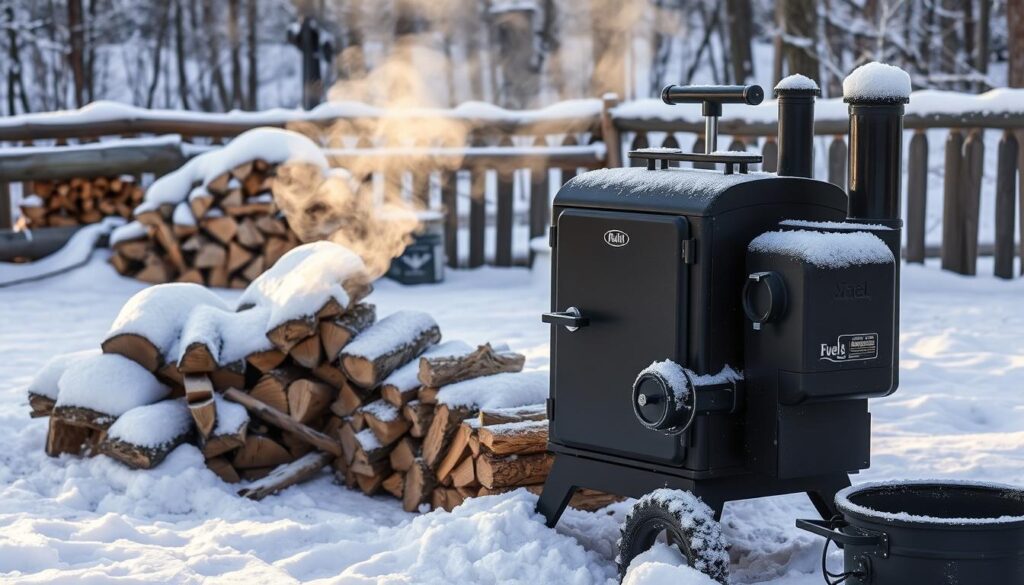
Safety Precautions for Outdoor Smoking
Smoking meat outdoors means you need to be extra careful. First, make sure the area around your smoker is clear of snow, ice, or anything that could cause you to slip. Also, place your smoker in a spot that’s protected from the elements. This means it should be away from branches or structures that could fall and damage your equipment.
It’s important to keep an eye on your smoker’s temperature and how much fuel you have. You might need to make changes to keep everything cooking safely and evenly. By focusing on outdoor smoking safety, you can enjoy your hard work and taste delicious, weather-proof smoked meats.
- Clear the area around your smoker of snow, ice, and other obstacles to prevent slips and falls.
- Position your smoker in a sheltered spot, away from potential hazards like low-hanging branches or collapsing structures.
- Monitor your smoker’s temperature and fuel levels closely, making adjustments as needed.
| Safety Precaution | Benefit |
|---|---|
| Clearing the Area | Prevents slips and falls near the smoker |
| Sheltered Positioning | Protects the smoker from potential hazards like falling snow or branches |
| Monitoring Temperature and Fuel | Ensures safe and consistent cooking conditions |
By following these safety precautions for outdoor smoking, you can smoke meat in different weather without risking your safety or your equipment.
Hot Weather Smoking Techniques
Smoking meat in hot weather can be rewarding but also challenging. The summer heat can make your meat dry out fast and the smoke too strong. But, with the right techniques, you can beat the heat and enjoy perfectly smoked meats all summer.
Preventing Meat from Drying Out
To keep your meat juicy, try using a water pan or a misting system in your smoker. This adds moisture, keeping your meat tender and tasty, even when it’s very hot. Play around with where you put the water pan and how often you mist to find what works best for your smoker.
Managing Smoke and Heat Levels
Summer makes your smoker run hotter than usual. So, it’s important to manage your smoke and heat. Adjust your smoker’s airflow to control the fire’s oxygen, which helps keep the temperature and smoke right. Also, move your meat around to cook evenly and avoid hot spots.
With some trial and error, you can get the hang of smoking meat in hot weather. By adjusting your methods for summer, you’ll enjoy juicy, tasty smoked meats all season.
Rainy and Humid Conditions
Smoking meat can be a fun cooking task, but it gets tricky with rain and humidity. These conditions can mess with the smoking process and lower the quality of your meat. But, with some smart steps, you can still get great-tasting smoked meats, even when the weather is bad.
Protecting the Smoker from Moisture
To keep your smoker dry, think about using a cover or placing it under something like a porch or awning. This keeps your smoker safe from rain and keeps moisture out of the smoking area. You might also look into smokers made to handle wet weather.
Adjusting Cook Times and Temperatures
Humidity and rain make meat cook slower and absorb smoke differently. You might need to up the heat a bit and watch your meat more closely. This helps your meat cook right without drying out. Always check your temperature and adjust as needed while cooking.
| Weather Condition | Smoker Protection | Cooking Adjustments |
|---|---|---|
| Rainy | Use a cover or shelter the smoker | Increase temperature, monitor closely |
| Humid | Weatherproof or waterproof smoker model | Adjust cook times and temperatures as needed |
By protecting your smoker from moisture and tweaking your cooking, you can beat the rain and humidity. This way, you’ll get to enjoy tasty smoked meats, no matter the weather.
Smoking meat in different weather
Smoking meat is a year-round hobby that goes beyond the weather. You can enjoy the rich, smoky taste of your favorite meats in any season. Just adjust your smoking methods to fit the weather.
Mastering All-Season Smoking
To smoke meat in different climates, be flexible. Pick a smoker that can handle the weather. Look for one that’s strong and well-insulated to keep temperatures steady.
In the cold, wrap your smoker to keep the heat in. In the heat, choose smokers with good airflow and cooling features.
Choosing the right fuel is key. In winter, use hardwood charcoal or logs that burn long and hot. This keeps your meat at the right temperature. In summer, pick fuels that burn fast but don’t dry out your meat.
- Invest in a versatile smoker with all-weather capabilities.
- Adjust your fuel choices to match the climate – heartier in cold, lighter in heat.
- Monitor temperatures closely and make real-time adjustments to airflow and heat levels.
With practice and an open mind, you can smoke delicious meats all year. Your friends and family will love them, no matter the weather.
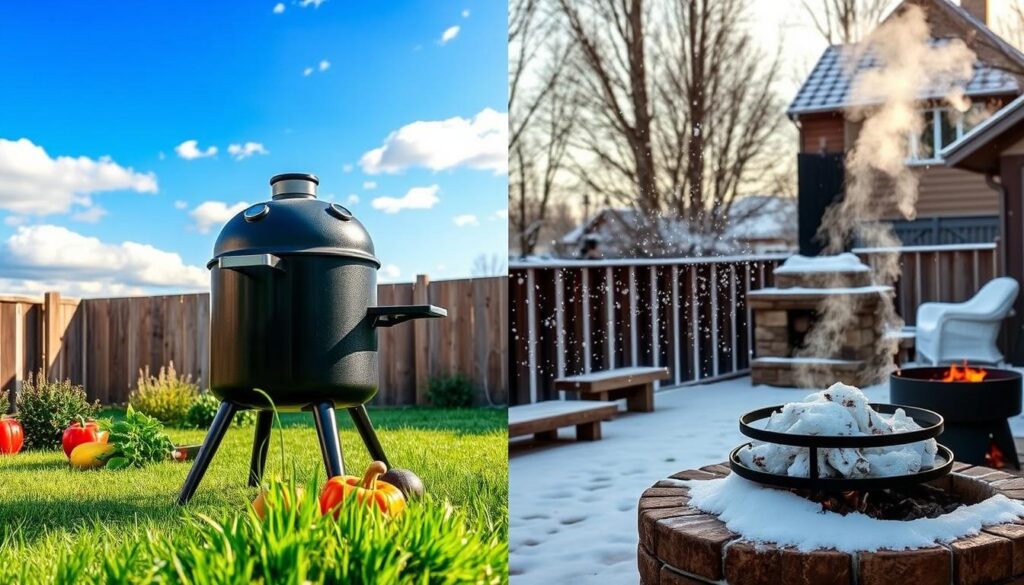
Outdoor Smoking in Windy Conditions
Smoking meat can be a fun and tasty activity, but windy weather can make it tough. The wind can mess with the smoker’s temperature and smoke balance. But, with some smart moves, you can beat the wind and get delicious smoked meats.
Positioning the Smoker for Optimal Airflow
To smoke meat well in windy weather, place your smoker in a spot that controls the airflow. Find a place that shields it from the wind. Make sure your smoker’s vents and openings face away from the wind. This keeps the air flowing steadily, helping you control the temperature and smoke for great smoked meats.
By placing your smoker right, you can guide the airflow to improve smoking. This keeps the temperature right and smoke levels just so, giving your meat the perfect flavor.
The wind can change, so watch your smoker closely and adjust as needed. With some trial and error, you’ll get the hang of smoking meat in windy weather. You’ll make tasty results every time.
| Tip | Description |
|---|---|
| Shelter the Smoker | Look for a spot that blocks the wind, such as a sheltered area or a corner of your patio. |
| Orientate the Vents | Position your smoker’s vents and openings away from the direction of the prevailing wind. |
| Monitor and Adjust | Keep a close eye on your smoker and be ready to make adjustments to maintain the ideal temperature and smoke levels. |
Temperature Monitoring Tools
When smoking meat, getting the temperature right is key, especially with changing weather. High-quality thermometers and probes are a must for great results. Look for ones that connect to Bluetooth for remote checks and have quick, precise readings.
Keeping an eye on your smoker and meat’s temperature lets you adjust as needed. This ensures perfect results, no matter the weather. Proper temperature control is key for great flavor and texture in smoked meats. Reliable thermometers are a smart choice for anyone serious about meat smoking techniques.
Investing in Reliable Thermometers
Choosing the right thermometers for smoking means looking for certain features:
- Bluetooth connectivity for checking temperatures from afar
- Digital displays that show temperatures quickly and accurately
- Probes that can handle the smoker’s heat
- Ability to track both smoker and meat temperatures at once
- Easy-to-use apps for controlling temperatures on your phone
| Thermometer Feature | Benefit |
|---|---|
| Bluetooth connectivity | Let’s you check temperatures without opening the smoker |
| Digital display with fast readings | Gives you up-to-the-minute temperature updates for quick changes |
| Durable, heat-resistant probes | Can handle the smoker’s high temperatures |
| Multi-channel tracking | Allows monitoring of both smoker and meat temperatures at once |
| User-friendly mobile app | Makes controlling temperatures easy from your phone |
With reliable thermometers, you can control the smoking temperature perfectly. This ensures your smoked meats are always cooked just right, no matter the weather.
“Precise temperature monitoring is the key to consistently delicious smoked meats. Investing in the right thermometers is a small price to pay for professional-quality results.”
Conclusion
Smoking meat is a rewarding way to cook that you can do all year, even with changing weather. By knowing how to handle different climates, you can make delicious smoked meats anytime. This makes you a master smoker, ready for whatever the weather brings.
Learn how to keep your smoker warm in the cold and cool in the heat. It’s all about being flexible, trying new things, and keeping an eye on temperature, fuel, and safety. This guide gives you the tips you need to smoke meat in any weather, so you can enjoy its smoky taste all year.
No matter the season, from winter’s cold to summer’s heat, smoking meat is always a delight. Use all-season smoking and weather-proof smoking techniques to overcome any challenge. Enjoy making tasty, smoked meats in every season and share your love for smoking with every bite.
FAQ
What are the key considerations for smoking meat in cold weather?
To smoke meat well in cold weather, pick a smoker made for cold use. It should have good insulation and keep heat in. Also, place your smoker in a spot that’s protected from the wind and snow.
How can you maintain consistent temperatures when smoking meat in variable weather conditions?
Get a good digital or Bluetooth meat thermometer. This lets you watch the smoker and meat’s temperature closely. You can then adjust the smoker’s airflow, fuel, and temperature to keep it perfect, no matter the weather.
How can you ensure you have enough fuel when smoking meat in cold weather?
In cold weather, your smoker eats fuel faster to stay hot. Use quality fuel like lump charcoal or hardwood chunks. Also, have extra fuel ready to avoid running out during cooking.
What safety considerations are important when smoking meat outdoors in variable weather?
Clear the area around your smoker of snow and ice to avoid accidents. Put your smoker in a spot that’s safe from falling snow or branches. Watch the temperature and fuel closely, and adjust as needed to keep cooking safely.
How can you prevent meat from drying out when smoking in hot weather?
To stop meat from drying out in hot weather, use a water pan or misting system. This adds moisture to the smoker. Also, control your smoke and heat to keep your smoker at a good temperature.
How can you overcome the challenges of rainy and humid weather when smoking meat?
Use a cover or keep your smoker under a porch in rainy and humid weather. Adjust your cooking times and temperatures as needed because humidity changes how fast the meat cooks and smokes.
How can you ensure consistent airflow when smoking meat in windy conditions?
To deal with windy conditions, place your smoker in a spot that blocks the wind. Make sure vents and openings face away from the wind. This helps keep air flowing evenly, letting you control temperature and smoke.
What type of temperature monitoring tools are essential for smoking meat in variable weather?
For smoking in changing weather, get top-notch meat thermometers and probes. Bluetooth connectivity is a plus for remote monitoring. These tools help you keep an eye on your smoker and meat’s temperature, ensuring perfect results.
How to Prepare and Smoke Chicken for BBQ Competitions
Are you ready to boost your BBQ skills and win at competitions? The key is to learn how to prepare and smoke chicken perfectly. Wondering what makes the winners stand out? Get ready to learn the secrets that will make your chicken dishes win prizes.
Key Takeaways
- Understand the importance of selecting the right chicken cuts for competition-worthy dishes
- Learn the art of trimming and shaping chicken thighs to create the perfect “pillow” presentation
- Discover the role of brining and seasoning in achieving mouthwatering, juicy chicken
- Explore the various smoking methods that can impart delectable flavors to your competition chicken
- Master the techniques for saucing and glazing your smoked chicken to dazzle the judges
Importance of Choosing the Right Cuts
Choosing the right cut of chicken is key for BBQ competitions. While chicken breasts are popular, chicken thighs are the top choice for smoked chicken recipes.
Why Chicken Thighs are the Preferred Choice
Chicken thighs are perfect for smoking because of their dark meat. They are juicy and flavorful, making them great for competition chicken. The rich taste of dark meat chicken shines with smoke, making your dish stand out.
Tips for Selecting the Best Chicken Thighs
- Look for evenly sized thighs to ensure a consistent appearance in the turn-in box.
- Opt for skin-on, bone-in thighs for maximum moisture and flavor.
- Purchase a few extra thighs to account for any issues that may arise during preparation.
Choosing the right chicken thighs and preparing them well will help you make a winning smoked chicken dish. This will impress the judges at your next BBQ competition.
Trimming and Preparing the Chicken Thighs
Trimming and preparing chicken thighs is key to a great competition entry. First, peel the skin from the thigh’s top, leaving a bit attached. Then, scrape off any extra fat. Next, cut off the knuckle and remove fat or veins with a knife or shears.
Finally, fold the skin over the meat to make the “chicken pillow” shape. This is what judges love to see.
Step-by-Step Guide to Trimming Chicken Thighs
- Peel the skin from the top of the chicken thigh, leaving part of it attached.
- Use a boning knife or kitchen shears to carefully scrape off any excess fat.
- Snip off the knuckle on the bone.
- Remove any remaining pockets of fat or veins.
- Fold the skin back over the meat, creating a “chicken pillow” shape.
Creating the Perfect Chicken Pillow Shape
The “chicken pillow” shape is a top choice for competition chicken. Folding the skin over the meat makes it look uniform and neat. This makes your chicken stand out to judges.
“The perfect chicken pillow shape is a must for any serious competition entry. It shows the judges that you’ve taken the time to meticulously prepare your chicken thighs.”
| Trimming Technique | Benefit |
|---|---|
| Chicken thigh trimming | Enhances the overall chicken appearance and presentation |
| Competition chicken prep | Helps the chicken thigh achieve the coveted “pillow” shape |
| Chicken pillow shape | Impresses judges with the attention to detail and craftsmanship |
Brining and Seasoning Techniques
Brining and seasoning are key steps for BBQ chicken. They make a big difference in the final taste. Brining chicken thighs before smoking keeps the meat moist and tasty. The brine mix, with water, salt, sugar, and seasonings, tenderizes the meat and adds flavor.
The Importance of Brining
Brining chicken thighs changes the game. It makes the meat juicy and tender. This step also lets the seasonings go deeper, giving a rich flavor.
Seasoning with BBQ rubs or marinades is also vital. These blends add a unique taste that can win over judges.
“Brining and seasoning are the cornerstones of truly exceptional smoked chicken for BBQ competitions.”
Mastering these techniques can take your chicken to the top. Don’t overlook the brine or seasoning. They’re the secrets to a memorable smoked chicken dish.
Smoke chicken for BBQ competitions
Smoking chicken for BBQ competitions requires precision and focus. Getting the smoke flavor and juicy meat right can win over judges. Two top methods for smoking chicken are the mini loaf pan and regular loaf pan methods.
Mini Loaf Pan Smoking Technique
The mini loaf pan method smokes chicken thighs at 275-300°F for 2-3 hours. It reaches an internal temperature of 165°F. This method controls temperature well, making sure the meat is fully cooked and the skin is crispy.
Regular Loaf Pan Smoking Technique
The regular loaf pan method is similar but uses a bigger pan for more chicken. It also smokes at the same temperature and time to get the best smoke flavor and tender meat.
| Smoking Method | Temperature | Duration |
|---|---|---|
| Mini Loaf Pan | 275-300°F | 2-3 hours |
| Regular Loaf Pan | 275-300°F | 2-3 hours |
Choosing any method, keeping a steady temperature is key. This makes sure the chicken is fully cooked and the smoke flavor spreads evenly. This results in a delicious dish that will impress the judges.
“The secret to winning BBQ competitions is in the smoke – it’s all about achieving that perfect balance of flavor and texture.”
Mastering smoking chicken for BBQ competitions can boost your skills. With the right techniques and focus, you could win that championship title.
Cooking Methods for Smoked Chicken Thighs
Choosing the right cooking method is key for smoked chicken thighs in BBQ competitions. Two top techniques stand out: the mini loaf pan and regular loaf pan methods. Both deliver juicy, flavorful results.
Mini Loaf Pan Smoking Method
The mini loaf pan method is great for perfect smoked chicken thighs. Season the chicken with your favorite rub or marinade first. Next, put them in a mini loaf pan with some chicken broth and butter.
Smoke the thighs at 275-300°F for about 1 hour and 15 minutes. Flip them and smoke for another 45 minutes to cook evenly.
Regular Loaf Pan Smoking Method
For a traditional method, try the regular loaf pan. Use big aluminum pans for 3-4 smoked chicken thighs each. Marinate the thighs, then add butter to the pan.
Smoke at 275°F for 45 minutes, cover with foil, and cook for 20 more minutes. This locks in the juices and tenderness.
Both the mini and regular loaf pan methods are top choices for competition chicken cooking. They help make smoked chicken thighs that will wow the judges at your BBQ competition. Try these methods and see which one works best for you.
Saucing and Glazing the Chicken
As the final stages of the smoking process approach, it’s time to elevate your competition chicken with a flavorful saucing and glazing technique. The key to success lies in mastering the art of competition chicken saucing and glazing chicken to create an irresistible BBQ sauce application.
First, carefully remove the smoked chicken thighs from their pans, ensuring you don’t disrupt the delicate texture. Now, it’s time to introduce your signature BBQ sauce to the mix. Combine the rich pan juices with your custom-crafted sauce, creating a harmonious blend that will both enhance and accentuate the smoky flavors of the chicken.
Using seafood forks, meticulously apply the sauce to the chicken thighs, coating each piece evenly. The goal is to achieve a glossy, appetizing appearance that will captivate the judges’ attention. Once the thighs are thoroughly sauced, return them to the smoker for an additional 10 minutes, allowing the sauce to set and form a delectable glaze.
“The perfect balance of sweet, tangy, and smoky flavors can make all the difference in a BBQ competition.”
This final step in the saucing and glazing process is a crucial one, as it elevates the appearance and taste of your competition chicken, setting it apart from the rest. By mastering this technique, you’ll ensure your chicken stands out on the judge’s table, leaving a lasting impression that could lead you to victory.
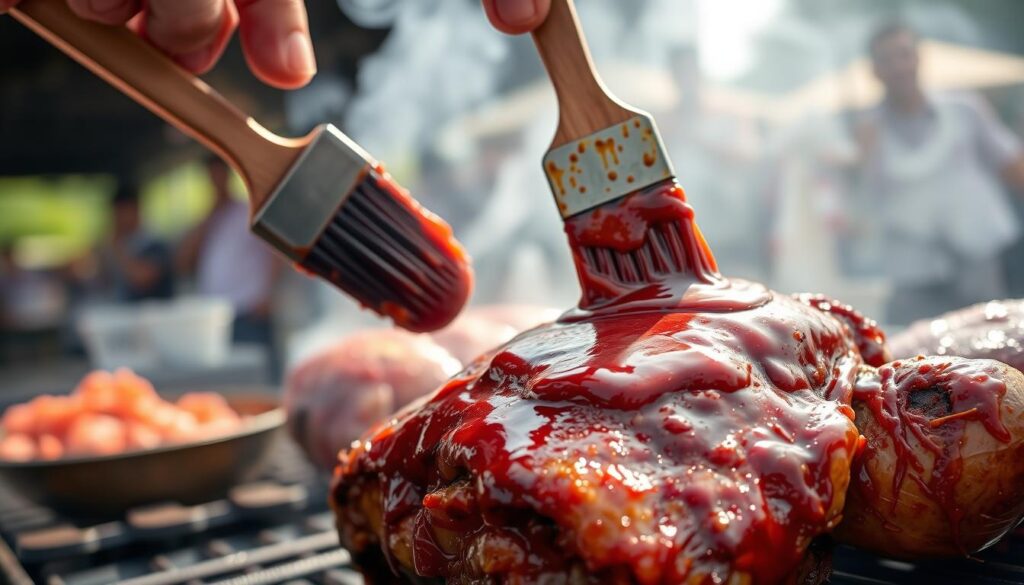
Temperature Control and Monitoring
Getting the perfect internal temperature is key for smoked chicken that wins. It’s all about keeping an eye on the temperature to make sure your chicken thighs are juicy and tender. This will make sure you impress the judges.
Mastering the Meat Thermometer
A top-notch meat thermometer, like the famous Thermapen, is a must-have for serious barbecue. Stick it into the chicken thigh’s thickest part to check if it hits 165°F. This is the perfect temperature for competition chicken.
Monitoring the Smoking Environment
Keeping your smoker or grill at the right temperature is as important as the chicken’s internal temperature. A dual-probe thermometer like the Thermoworks Smoke helps you monitor the smoking environment. This ensures it stays between 275-300°F for the best taste.
“Precise temperature control is the hallmark of a true barbecue master. With the right tools and techniques, you can elevate your competition chicken to new heights.”
Using a dependable meat thermometer and a dual-probe temperature monitoring system is the way to go. This combo helps you hit the perfect competition chicken internal temperature every time.
Presentation and Turn-In Box Tips
The final step in a BBQ competition is presenting your smoked chicken thighs in the turn-in box. Judges look at how uniform, neat, and appetizing your dish looks. To make a great impression, follow these tips:
- Pick the six best-looking chicken thighs from your batch. Make sure they are the same size, shape, and color.
- Put the thighs in the turn-in box on a bed of fresh, vibrant leafy greens. This makes your chicken look great.
- Clean up any sauce smears or drips on the thighs or the box. A clean look is important.
It’s key to know the BBQ competition rules. Learn about the turn-in box rules, like how many pieces you can bring, what garnishes you can use, and any other presentation guidelines. Following these rules is crucial for your Competition chicken presentation.
| Presentation Criteria | Scoring Considerations |
|---|---|
| Uniformity | Thighs should be consistent in size, shape, and color |
| Neatness | Clean, tidy arrangement in the turn-in box with minimal sauce drips |
| Appetizing Appearance | Visually appealing, with a mouth-watering presentation that showcases your BBQ competition rules |
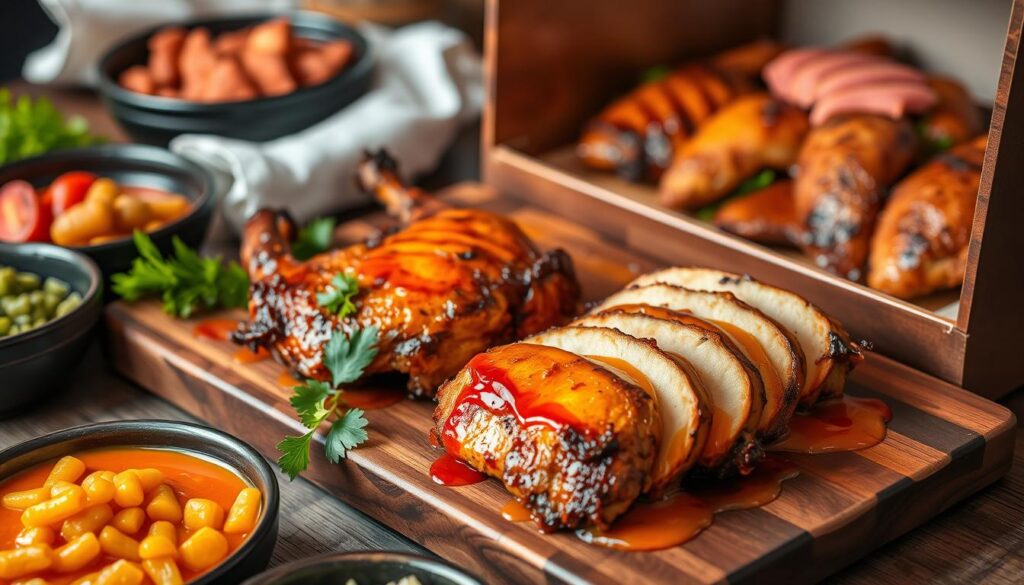
By following these tips for presentation and turn-in box setup, you’ll impress the judges. This could help you win your next BBQ competition.
Rubs and Seasoning Blends
Making the perfect seasoning blend is key to making your smoked chicken thighs stand out. It’s all about finding the right mix of savory, sweet, and aromatic flavors. As you search for the best BBQ rubs and seasoning blends, try different spices and herbs. This will help you create competition chicken flavors that make your dish unique.
Creating Memorable Flavor Profiles
To make a seasoning blend that wows, start with the basics. Use salt, brown sugar, and black pepper as your foundation. Then, add umami with garlic powder, onion powder, and smoked paprika. Finally, add some heat with cayenne pepper or chipotle chili powder for a complex taste.
Creating great BBQ rubs and seasoning blends is all about balance. Try different mixes until you find one that you and the judges will love.
| Ingredient | Purpose |
|---|---|
| Kosher Salt | Enhances the natural flavors of the chicken |
| Brown Sugar | Adds a subtle sweetness and caramelization |
| Black Pepper | Provides a warm, peppery kick |
| Garlic Powder | Contributes savory, umami notes |
| Onion Powder | Enhances the overall depth of flavor |
| Smoked Paprika | Adds a subtle smoky undertone |
| Cayenne Pepper | Introduces a touch of heat |
With careful attention to your BBQ rubs and seasoning blends, you’re on your way to making competition chicken flavors that will impress. These flavors will set your chicken apart and make a lasting impression on the judges.
Wood Chip Varieties for Smoking
Choosing the right wood chips is key to a great BBQ competition chicken. Trying out different wood chips is crucial for that amazing smoke flavor. From the classic hickory to sweet fruit woods, the right mix can take your chicken to the next level.
For a balanced, smoky taste, mix different wood chips. Hickory adds a strong, bacon-like flavor. Apple or cherry wood brings a sweet touch.
| Wood Chip Variety | Flavor Profile | Best for Smoking |
|---|---|---|
| Hickory | Robust, bacon-like | Beef, pork, and chicken |
| Apple | Sweet, fruity | Poultry and pork |
| Cherry | Mild, slightly sweet | Poultry and pork |
| Oak | Earthy, robust | Beef and pork |
Try different wood chip mixes to find the best wood chips for smoking and competition chicken smoke flavor. This will make your chicken shine at competitions.
“The right wood chips can make all the difference in the world when it comes to smoked chicken. It’s all about finding the perfect blend to create that unforgettable competition-worthy flavor.”
Conclusion
This guide has shown you how to make award-winning smoked chicken for BBQ competitions. It takes a keen eye and dedication to every step. You now know how to pick the best chicken thighs and season and smoke them perfectly.
With the expert advice in this article, you’re ready to take on smoked chicken preparation. You can win your next BBQ competition, whether you’re experienced or new. The tips here will help you make smoked chicken that wows the judges.
The journey to making great smoked chicken never ends. It’s a chance to try new things, improve your skills, and explore new flavors. Keep learning from your wins and mistakes. Let your love for barbecue lead you to success. With this guide, you’re on your way to BBQ victory.
FAQ
Why are chicken thighs the preferred choice for BBQ competitions?
Chicken thighs are top picks for BBQ contests because they’re juicier and tastier than breasts. Their dark meat is perfect for slow smoking. It stays moist and flavorful.
How should chicken thighs be trimmed and prepared for BBQ competitions?
Getting the chicken thighs ready is key for a great BBQ entry. Start by peeling the skin from the top, leaving some attached. Then, remove excess fat.
Next, cut off the knuckle bone and take out any extra fat or veins. Finally, fold the skin over the meat to make it look neat and uniform.
Why is brining the chicken thighs before smoking important?
Brining chicken thighs before smoking keeps them moist and full of flavor. The brine mix, with water, salt, sugar, and spices, tenderizes the meat and adds flavor.
What are the two successful smoking methods for BBQ competition chicken thighs?
There are two top smoking methods for BBQ chicken thighs. Both use a consistent temperature of 275-300°F for a set time. This makes sure the meat is fully cooked and the skin is crispy.
How important is temperature control and monitoring when smoking chicken for BBQ competitions?
Keeping the chicken at the right internal temperature is key for perfect texture and doneness. Use a meat thermometer like the Thermapen to hit 165°F. Also, monitor the grill temperature with a dual-probe thermometer to keep it steady at 275-300°F.
What tips are provided for the presentation of the chicken thighs in the turn-in box?
Pick the six best-looking thighs and place them on a bed of greens in the box. Clean up any sauce spills for a neat look. Remember to follow the competition’s rules for a winning entry.
How important is the seasoning blend or rub for BBQ competition chicken thighs?
A great seasoning blend or rub is crucial for the flavor of smoked chicken thighs. Aim for a mix of salt, sweet, pepper, and umami to stand out to the judges.
What types of wood chips are recommended for smoking competition chicken?
Use fruit woods like apple or cherry, with a bit of hickory. This mix creates a smoky flavor that enhances the dish’s taste.
Choosing the Best Fuel: Charcoal, Wood, or Pellets for Competition BBQ
Hey, grill masters! Ready to boost your competition BBQ skills? The key to amazing, award-winning BBQ is the fuel you pick. With charcoal, wood chunks, and wood pellets to choose from, finding the right one can be tough. Let’s explore the best fuel for your BBQ success.
Key Takeaways
- Charcoal, wood chunks, and wood pellets each offer unique benefits for competition BBQ
- Choosing the right fuel can make a significant difference in the flavor, smoke, and temperature control of your barbecue
- Understanding the pros and cons of each fuel type will help you select the perfect option for your competition BBQ needs
- Experimenting with fuel combinations can unlock even more complex and nuanced flavors
- Proper fuel management and temperature control are crucial for competition-level BBQ success
Introduction to Fuels for Competition BBQ
In competitive BBQ, the right fuel is key to perfect flavor, smoke, and temperature control. Whether you’re a pro or new to competition BBQ, knowing about competition BBQ fuels is vital for winning.
The Importance of Choosing the Right Fuel
Choosing the right BBQ fuel types is key for great flavors and steady temperatures in BBQ contests. The fuel you pick affects your dish’s aroma, texture, and taste. This can make or break your BBQ success.
Overview of Different Fuel Types
- Charcoal: A top pick for fuel for smokers and fuel for BBQ competitions, charcoal gives steady heat and smoky flavor to your meats.
- Wood Chunks and Logs: Hardwoods like oak, hickory, and maple add depth to your BBQ, making your dishes more complex.
- Wood Pellets: A modern choice, wood pellets offer steady heat and many flavor options for your competition BBQ fuels.
Each fuel has its own benefits and drawbacks. It’s important to know these to pick the best for your BBQ needs.
“The right fuel can make all the difference in a competition BBQ. It’s not just about the heat – it’s about the flavor, the smoke, and the overall experience you create for the judges.”
Charcoal: A Classic Choice for Competition BBQ
Charcoal is a top pick for fueling competition BBQ. It’s loved for its smoky taste, whether you choose hardwood lump charcoal or charcoal briquettes. These fuels are favorites among pit masters for their benefits.
Lump Charcoal vs. Briquettes
Lump charcoal comes from burning hardwood logs in a low-oxygen setting. This makes it pure and gives it a distinct, wood-like smell. Briquettes mix charcoal, coal, and additives for a steady burn.
Advantages and Disadvantages of Charcoal
Here are the pros and cons of charcoal for BBQ:
- Advantages:
- It adds a deep, smoky taste to meat.
- It burns consistently and reliably.
- It lets you control the temperature well.
- It’s affordable and easy to find.
- Disadvantages:
- It needs more attention to keep the temperature right.
- It makes more ash and debris than other fuels.
- It can be messier to use than pellets or wood chunks.
Choosing between hardwood lump charcoal and charcoal briquettes depends on what you like and your BBQ needs. Both are trusted by pit masters for making delicious BBQ.
Hardwood Chunks and Logs: Adding Flavor to Your BBQ
As a competition BBQ enthusiast, you know the secret to great dishes is not just the heat. It’s also the hardwood chunks or logs you add. These natural elements bring a rich, smoky flavor to your meats and veggies. This can take your competition dishes to the next level.
When picking wood chunks, you have many options, each with its own unique taste. Hickory, oak, mesquite, and apple are popular choices. Try different woods to find the perfect match for your seasonings and cooking style.
- Hickory wood chunks provide a bold, bacon-like flavor, perfect for hearty meats like brisket and ribs.
- Oak wood chunks offer a mild, slightly sweet taste that pairs well with poultry and pork.
- Mesquite wood chunks impart a robust, earthy flavor, ideal for grilling steaks and burgers.
- Apple wood chunks add a subtle, fruity aroma that can enhance the natural sweetness of meats and vegetables.
To add wood flavor to your BBQ, you can put the chunks right on the heat or wrap them in foil with small holes. Try different ways to see what works best for you and your dish.
Mastering wood chunks in competition BBQ takes patience and experimentation. Start with a little and add more until you get the smoke and flavor you want. With time and practice, you’ll make dishes that truly show off the grill’s power.
Pellets: The Modern Fuel for Competition BBQ
Wood pellets are now a top choice for competitive barbecuing. They are small, uniform pieces of compressed hardwood. They make it easy to get the right flavor and temperature for your dishes.
Understanding Wood Pellet Composition
Wood pellets are created by pressing together dried and ground hardwood. This includes sawdust or wood shavings. This method ensures a steady burn and consistent heat, making them a favorite among BBQ pros.
Variety of Wood Pellet Flavors
Wood pellets offer a wide range of flavors for BBQ. You can choose from classic options like oak and hickory to unique ones like maple and cherry. This lets you experiment and find the best flavor for your meats.
| Wood Pellet Flavor | Ideal for |
|---|---|
| Oak | Beef, Pork |
| Hickory | Beef, Pork, Poultry |
| Maple | Poultry, Vegetables |
| Cherry | Pork, Poultry |
| Mesquite | Beef, Pork |
Choosing the right wood pellet flavor can take your BBQ to the next level. It shows off your skill in smoke and flavor.
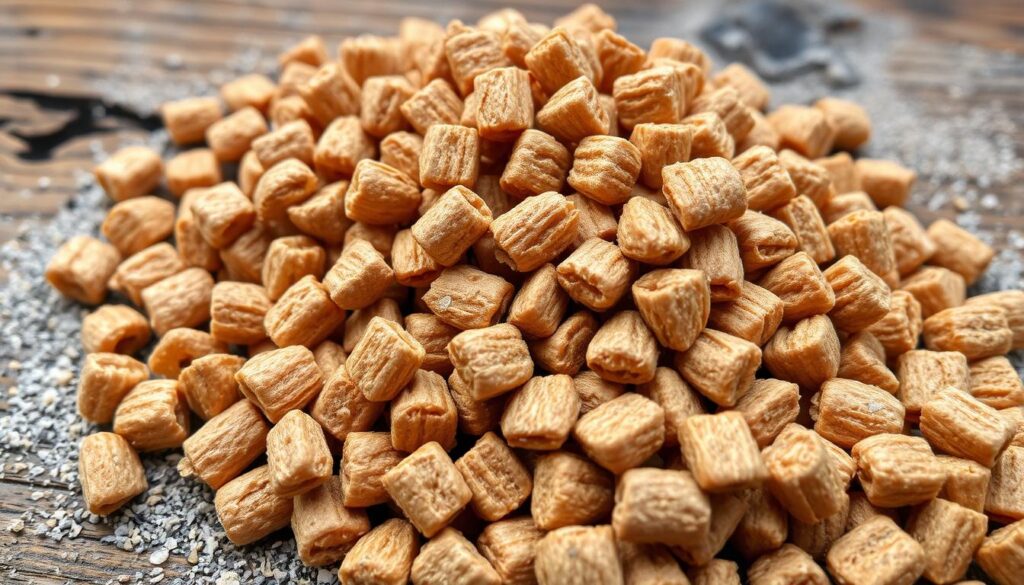
Best Fuel for BBQ Competitions
Choosing the right fuel is key in competition BBQ. You can pick from classic charcoal, aromatic wood chunks, or modern wood pellets. Each has its own benefits that affect your BBQ’s flavor, smoke, and performance. Think about these factors to pick the best fuel for BBQ competitions.
Charcoal: A Consistent Performer
Charcoal is a top choice for competition BBQ. It gives a steady heat that helps you control the temperature well. Lump charcoal is especially good because it burns clean and adds a subtle flavor to your food.
Wood Chunks: Enhancing Flavor
Wood chunks are great for adding a smoky taste to your BBQ. Hardwoods like oak, maple, and hickory bring a unique aroma to your dishes. Adding wood chunks to your charcoal setup can really make your BBQ stand out.
Pellets: Convenience and Consistency
Pellet grills are becoming more popular in competition BBQ for their ease and temperature control. Competition BBQ fuels like premium wood pellets come in many flavors. They burn consistently and are easy to manage, making them a favorite among pitmasters.
The best fuel for BBQ competitions depends on what you like and the competition’s rules. Try different fuels and mixes to find what works best for you. This will help you shine in the competition BBQ world.
“The secret to winning competition BBQ is mastering the art of fuel selection and management.” – Pitmaster John Doe
Pairing Fuels with Different Types of Meats
In competition BBQ, the meat you cook changes the best fuel choice. Choosing the right fuel, like charcoal, wood chunks, or wood pellets, is key. It makes a big difference in the flavors and results you get.
Best Fuels for Beef
For beef, pick a fuel that adds a rich, smoky taste. Lump charcoal or charcoal mixed with hardwood chunks, like oak or hickory, works great. This mix gives the beef a nice crust and keeps the juices in.
Best Fuels for Pork
Pork goes well with many wood flavors. Wood pellets from fruit woods, like apple or cherry, add a sweet touch that goes well with pork. Or, mix wood pellets with charcoal for smoke and heat balance.
Best Fuels for Poultry
- For poultry, a light, delicate smoke is best. Wood pellets from maple or alder give a subtle, buttery flavor that brings out the bird’s natural taste.
- For more complex flavors, try mixing maple or alder pellets with a bit of mesquite or hickory. This adds bold, earthy smoke.
| Meat Type | Best Fuels |
|---|---|
| Beef | Lump charcoal, Charcoal and hardwood chunks (oak, hickory) |
| Pork | Fruit wood pellets (apple, cherry), Blend of wood pellets and charcoal |
| Poultry | Maple or alder wood pellets, Blend of maple/alder and mesquite/hickory pellets |
“The key to winning a BBQ competition is mastering the art of fuel selection and management. Each meat type requires a unique approach to ensure the perfect balance of smoke, heat, and flavor.”
Tips for Fuel Management and Temperature Control
Keeping temperatures steady is key in competition BBQ. Different fuels need different ways to manage heat. This section offers tips and techniques for controlling heat with charcoal or wood pellets. This ensures your dishes are cooked just right.
Controlling Temperature with Charcoal
Using charcoal, managing air flow is crucial for temperature control. Adjust your grill or smoker vents to change oxygen flow to the coals. This affects the fire’s strength. Also, arrange charcoal in a way that creates different heat zones.
This lets you sear, roast, or slow-cook meats as needed. Try different charcoal placements and amounts to get the right balance for your dishes.
Controlling Temperature with Wood Pellets
Wood pellets offer convenience and flavor. For consistent temperatures, manage your pellets well. Adjust the pellet feed rate and air flow to control the heat. This ensures even heat for great results. Always check and refill your pellet hopper to keep temperatures steady during the competition.
No matter your fuel choice, controlling temperature is key in competition BBQ. Follow these tips to master temperature control. This will help you cook meats perfectly, impress judges, and win over competitors.
Combining Fuels for Unique Flavors
In competitive barbecue, finding that special flavor is key. Each fuel type – charcoal, wood chunks, and wood pellets – has its own strengths. But the best grill masters blend these to create unique tastes. This blending lets you make smoking profiles that make your food stand out.
Understanding each fuel’s unique qualities is crucial. Lump charcoal burns hot and clean, giving a steady heat. Hardwood chunks add a strong smoke flavor that goes well with beef or pork. Wood pellets offer a subtle smoke that can match any meat.
By mixing these fuels, you can make flavors that take your BBQ to the next level. Try combining different woods or adding charcoal to your hardwood for the right mix of heat and flavor. With creativity, the options are endless in combining fuels for unique flavors.
| Fuel Combination | Flavor Profile | Best Suited for |
|---|---|---|
| Lump Charcoal + Hickory Chunks | Bold, Smoky, Slightly Sweet | Beef Brisket, Pork Shoulder |
| Oak Pellets + Maple Chips | Nuanced, Subtly Sweet, Slightly Nutty | Turkey, Chicken |
| Mesquite Chunks + Lump Charcoal | Intense, Earthy, Robust | Beef Ribs, Lamb |
Starting your competition BBQ fuel combinations journey means finding the right balance of flavors. With some trial and a lot of passion, you can make smoking profiles that wow judges and win competitions.
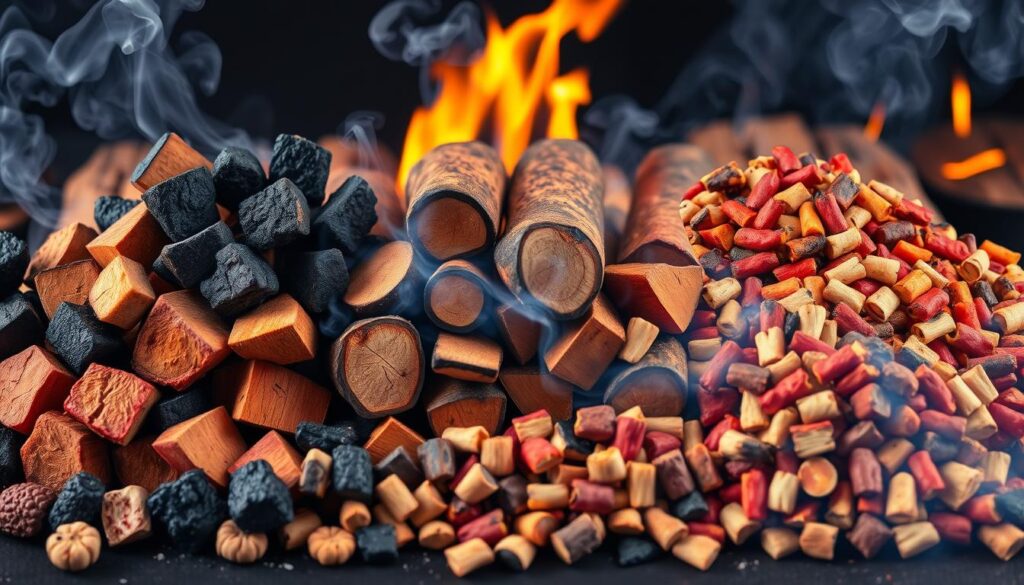
“The secret to competition-worthy barbecue is in the fuel. By combining the right elements, you can unlock a world of flavor that sets your dishes apart.”
Conclusion
Choosing the right fuel is key to winning in BBQ competitions. You can pick from classic charcoal, aromatic hardwood chunks, or modern wood pellets. Each has its own benefits that can make your dishes stand out.
Success comes from knowing the unique traits and flavors of each fuel. Then, match them with the right meats and cooking methods. This way, you can show off your cooking skills. Mastering fuel and temperature control will help you win.
Before your next BBQ competition, look into all the fuel options. Find the one that sparks your passion for BBQ. With the right fuel, you can make amazing dishes. This will lead you straight to the top.
FAQ
What are the main types of fuel used in competition BBQ?
The main fuels for competition BBQ are charcoal, hardwood chunks or logs, and wood pellets.
What are the advantages of using lump charcoal versus charcoal briquettes for competition BBQ?
Lump charcoal burns hotter and leaves less ash, giving you consistent temperatures. Charcoal briquettes are easy to manage because they’re uniform in size and shape.
How do hardwood chunks and logs contribute to the flavor of competition BBQ dishes?
Hardwood chunks or logs add rich, smoky flavors to your BBQ. Different woods like oak, hickory, or maple can make your dishes taste unique.
What are the benefits of using wood pellets for competition BBQ?
Wood pellets are a versatile fuel for BBQ. They come in many flavors, making it easy to try different smoking styles. They also provide consistent heat and smoke for better temperature control.
How can you determine the best fuel or fuel combination for your competition BBQ needs?
Choosing the right fuel for BBQ means looking at charcoal, wood chunks, and wood pellets. Think about the meat you’re cooking, the flavors you want, and how well you can control the temperature.
How can you effectively control the temperature when using different fuel types in competition BBQ?
Keeping temperatures steady is key in BBQ. With charcoal, manage the airflow and fuel well. For wood pellets, know how your grill or smoker controls temperature to keep it right.
What are the benefits of experimenting with fuel combinations in competition BBQ?
Mixing charcoal, wood chunks, and wood pellets can create unique flavors for your BBQ. Trying different fuel mixes lets you make smoking profiles that stand out from others.
How to Smoke Pork Shoulder for BBQ Competitions
Do you dream of being a top pit master in BBQ competitions? The key to winning is mastering the art of smoking the perfect pork shoulder. But what makes that pulled pork so irresistible? Let’s dive into the secrets that will turn your backyard BBQ into a hit.
Key Takeaways
- Learn the essential steps to prepare and smoke pork shoulder for BBQ competitions
- Discover the importance of pork butt selection and how to identify the “money muscle”
- Explore the art of seasoning, smoking, and wrapping techniques to enhance flavor and texture
- Understand the critical role of temperature control and resting the meat for competition-winning results
- Gain insider tips on presentation and serving to impress the judges
The Perfect Bite: Competition-Style Pulled Pork
Getting the perfect bite of competition-style pulled pork starts with knowing the pork butt, or Boston butt. This cut comes from the pig’s shoulder. It’s loved by BBQ fans for its high fat and tender texture when cooked slowly.
Setting the Stage for Delicious Pork
The pork butt is often mixed up with the actual butt. But it’s a top choice for pulled pork. Its fat and muscle fibers are perfect for slow cooking. This makes it easy to get that “pull-apart” texture.
Understanding Pork Butt Cuts
- The pork butt, also known as the Boston butt, is a cut from the upper shoulder of the pig, not the actual butt.
- This cut is characterized by a solid layer of fat, typically around 1/4 inch thick, which helps to keep the meat moist and flavorful during the smoking process.
- The “money muscle,” a small, cylindrical-shaped portion of the pork butt, is considered the most tender and succulent part, making it a highly sought-after section for competition-style pulled pork.
Knowing the pork butt’s unique traits is key to making perfect pulled pork. By picking the right cut and preparing it well, you can boost your BBQ skills. This will impress even the toughest judges.
Selecting the Ideal Pork Butt
Choosing the right pork butt is key for competition-style pulled pork. The size, fat cap thickness, and finding the “money muscle” are important. These factors can help you win over the judges and take the top spot.
Size and Fat Cap Considerations
The best pork butt for competition should weigh between 8-10 lbs. This size offers a good balance of tenderness and size. The fat cap should be about 1/4 inch thick. This thickness keeps the meat moist and adds flavor, also creating a tasty bark on the outside.
The Elusive Money Muscle
The “money muscle” is a tender, cylindrical part of the pork butt. It’s crucial to find and keep this section in top shape for the judges. When picking your pork butt, make sure to spot and check the money muscle. It should be in great condition, ready to show off your cooking skills.
| Characteristic | Ideal Competition Pork Butt |
|---|---|
| Size | 8-10 lbs |
| Fat Cap Thickness | 1/4 inch |
| Money Muscle | Identifiable and in excellent condition |
“The key to winning a BBQ competition is in the selection and preparation of the pork butt. Get that right, and you’re well on your way to a championship-worthy pulled pork.”
Preparing the Pork Butt
Smoking the perfect pork shoulder for BBQ competitions begins with proper preparation. The first key step is to score the fat cap on the meat. This lets the seasoning rubs go deep into the pork, making every bite full of flavor.
Scoring the Fat Cap
Use a sharp knife to make a crosshatch pattern across the fat cap. Cut through the fat but not the meat. Aim for a depth of about 1/4 inch. This grid-like pattern aids in the pork butt preparation process.
Applying Binders and Seasonings
After scoring the fat cap, apply a binder. Use a light coating of mustard or olive oil to help the seasoning rubs stick. Cover the entire pork butt with your favorite dry rub. Choose a rub rich in sugar and salt, as the big pork butt needs lots of seasoning for that winning taste.
With the fat cap scoring and binder application done, your pork butt is set for the smoker. The effort you put into pork butt preparation will show in the delicious results.
Setting Up the Smoker
Getting your smoker setup right is key for a delicious, tender smoke flavor in your pork shoulder. Choosing the right wood selection is important to match the meat’s natural taste.
Wood Choices for Delicate Smoke Flavor
For smoking pork, a mix of post oak and pecan wood works best. These hardwoods give a gentle, rich smoke flavor that boosts the pork’s sweetness without being too strong.
Adding a bit of apple wood chips can add more depth. Apple wood’s mild fruitiness contrasts nicely with the post oak and pecan’s nuttiness.
- Post oak: Gives a deep, earthy smoke flavor that goes well with pork
- Pecan: Adds a light, sweet smoke flavor that enhances the pork’s taste
- Apple wood chips: Brings a touch of fruity sweetness to the smoke flavor
It’s important to keep the smoke flavor light and balanced. This lets the pork’s natural taste stand out. Before putting the pork in the smoker, wait for the smoke to become blue and thin. This means the smoke is clean and ready for a top-notch dish.
The Smoking Process
Mastering the smoking process is key to getting that perfect pork butt. You need to balance smoking temperature and cooking time well. This balance brings out the best in your pork shoulder.
Temperature and Timing
For smoking pork butt, keep the temperature at about 250°F most of the time. This slow cooking lets the fat and collagen melt, making the meat tender and juicy. Plan to cook it for 1.5 to 2 hours per pound, so a big cut could take 8 to 12 hours.
Spritzing for Bark Development
Regular spritzing is a secret to a great bark development on your pork butt. Mist it with apple juice every 60 to 90 minutes. The sugars in the juice help create a tasty, mahogany bark. This makes the meat look great and taste even better.
| Smoking Temperature | Cooking Time | Bark Development | Pork Butt Spritz |
|---|---|---|---|
| 250°F | 8-12 hours | Caramelized, mahogany-colored | Apple juice, every 60-90 minutes |
“The secret to competition-worthy pork is all in the low and slow smoking process. It’s a labor of love, but the end result is worth every minute.”
Smoke pork shoulder for BBQ competitions
As you near the end of smoking your pork shoulder for a BBQ contest, focus on wrapping and checking the temperature. This is key to making your pork shoulder stand out.
The Wrapping Technique
When your pork butt hits 165-175°F and looks great, move it to an aluminum pan. Douse it with apple juice, then wrap it in heavy-duty foil tightly. This method finishes the fat and collagen, making the meat tender and juicy.
Monitoring for Tenderness
Keep an eye on the pork shoulder’s internal temperature, aiming for 200-205°F. Use a digital thermometer to check for tenderness. You want it to be so tender that the “money muscle” pulls apart easily, showing off your smoking skills.
| Step | Description |
|---|---|
| 1. Wrap in Foil | Transfer the pork butt to an aluminum pan, sprinkle with apple juice, and tightly wrap in heavy-duty foil. |
| 2. Monitor Temperature | Aim for an internal temperature of 200-205°F, checking regularly with a digital thermometer. |
| 3. Check for Tenderness | Probe the meat to ensure the “money muscle” is tender and easily pulled apart. |
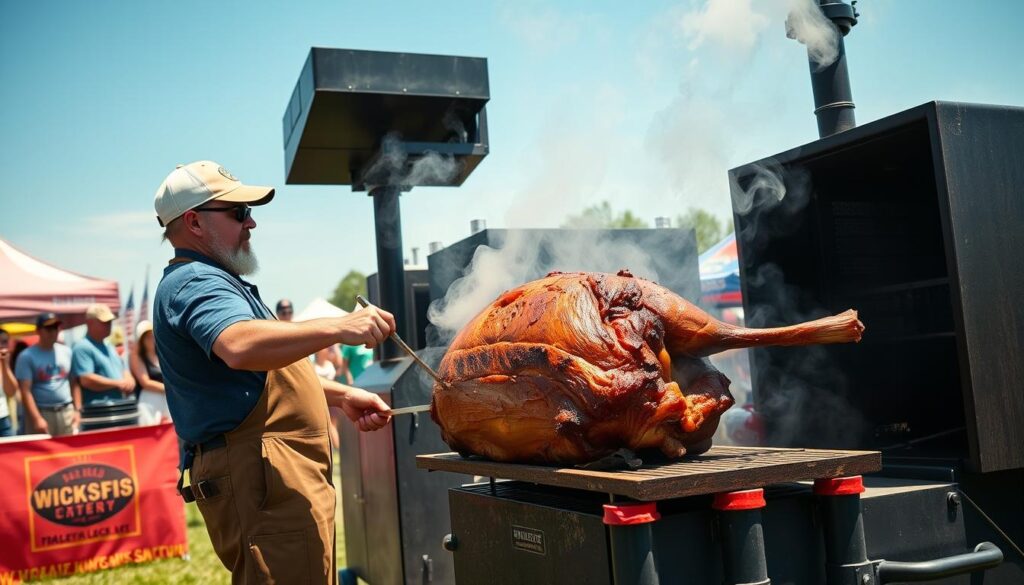
Mastering the wrapping and temperature checking will lead to a tender, juicy, and top-notch pork shoulder for competitions.
Resting the Pork Butt
After smoking the pork butt to perfection, the next step is just as important. This step lets the meat soak up its juices. This makes the meat tender and full of flavor. It will make your taste buds happy and impress your BBQ friends.
Insulating for Optimal Rest
It’s key to keep the pork butt warm and juicy after cooking. Move the meat to a warm place, like a Cambro Go Box or a cooler with towels. This keeps the meat warm for at least 30 minutes, or up to 4 hours if you need to.
Keep an eye on the pork butt temperature while it rests. This makes sure it stays in the perfect range for temperature maintenance. It keeps your pulled pork moist and full of flavor.
Patience is important here. Letting the pork butt rest is key for absorbing juices. This makes your BBQ tender and juicy, setting it apart from others.
Pulling and Serving
As you near the final stage of your pork butt preparation for the competition, it’s time to focus on the art of pork pulling techniques. The key is to preserve the integrity of the “money muscle” – the most tender and succulent part of the pork butt. Begin by carefully separating the muscles, removing any leftover membranes, fat, or cartilage to ensure a clean, uniform presentation.
Preserving the Money Muscle
The money muscle, a small, cylindrical-shaped portion of the pork butt, is the prized jewel of your competition entry. Treat it with the utmost care, gently pulling and shredding the meat to maintain its delicate texture and juicy flavor. This attention to detail will set your pulled pork apart from the rest, impressing the judges with its melt-in-your-mouth tenderness.
Final Seasoning Adjustments
- Once the pork is pulled, take a moment to assess the final seasoning adjustments needed to enhance the overall flavor profile.
- Consider adding a touch more salt, pepper, or your signature barbecue sauce to elevate the taste and ensure a harmonious balance.
- Remember, the money muscle preservation is crucial, so be mindful not to overpower the natural flavors of the meat.
| Pork Pulling Technique | Importance | Tips |
|---|---|---|
| Separating Muscles | Ensures a clean, uniform presentation | Carefully remove any leftover membranes, fat pockets, or cartilage |
| Preserving Money Muscle | Showcases the most tender and succulent part of the pork butt | Gently pull and shred the meat to maintain its delicate texture and juicy flavor |
| Final Seasoning Adjustments | Enhances the overall flavor profile | Add a touch more salt, pepper, or signature barbecue sauce, but don’t overpower the natural flavors |
“The key to a competition-worthy pulled pork is all in the technique – from preserving the money muscle to making those final seasoning touches. It’s a delicate balance that separates the champions from the rest.”
Competition-Winning Flavor Profiles
Getting the perfect flavor for your smoked pork shoulder is all about prep and strategy. Use injection marinades and seasoning rubs wisely. Learn from the Dizzy Pig team, who have won over a hundred BBQ contests with their pulled pork.
Injection Marinades: Infusing Moisture and Flavor
An injection marinade keeps your pork shoulder moist and full of flavor. Mix pork stock, MSG, sugar, and salt to inject into the meat. This adds a savory taste and keeps the pork juicy, avoiding dryness.
Seasoning Rubs: Building a Mouthwatering Bark
Use a dry rub like Dizzy Pig’s Crossroads or Raging River with your injection marinade. These rubs create a tasty bark on the pork, keeping it moist and adding complex flavors. Make sure to coat the pork well, letting the rub form a thick crust during smoking.
Mastering injection marinades and seasoning rubs can take your competition pork to the top. You’ll be on your way to becoming a Pitmaster Champion.
Temperature and Time Mastery
Getting the perfect temperature and managing cooking time is key in smoking pork shoulder for BBQ contests. Experts say these two elements are vital for tender, juicy, and flavorful pork that wows the judges.
A pork butt usually takes about 90 minutes per pound to cook at 250°F. But, the exact time can change based on the meat’s size and the smoker type. It’s important to watch the meat’s internal temperature closely. Aim for 200-205°F for the best tenderness and doneness.
| Temperature Control | Cooking Time Management |
|---|---|
| Maintain a consistent temperature of 250°F in your smoker to ensure even cooking and a tender, juicy pork butt. | Plan for around 90 minutes of cooking time per pound of pork, but be prepared to adjust based on the size of your cut and the specific characteristics of your smoker. |
| Use a reliable meat thermometer to closely monitor the internal temperature of the pork, aiming for 200-205°F for the perfect doneness. | Be patient and resist the urge to open the smoker too frequently, as this can affect the cooking time and smoke penetration. |
Mastering temperature control and cooking time will help you make competition-worthy pork shoulder. This will make your BBQ stand out. Remember, paying attention to details and sticking with the process is crucial for that perfect bite.
“The key to competition-worthy pork is temperature and time mastery. Nail those two elements, and you’ll be well on your way to BBQ glory.”
Wrapping and Resting Techniques
Once your pork butt reaches the right temperature and looks great, it’s time to wrap and rest it. These steps are key for the perfect texture and juiciness. They’ll impress the judges at your next BBQ competition.
Foil Wrapping for Moisture Retention
Wrapping your pork butt in foil tightly is crucial. Before wrapping, add a bit of liquid like apple juice or pork stock. This keeps the juices in and helps the fat and collagen melt, making the meat tender.
Controlled Resting for Texture Perfection
The resting time is as important as smoking. Let your pork butt rest for 1-4 hours, based on its size. This lets the meat relax and the texture get better. The juices will go back into the meat, making it juicy and easy to pull apart.
“Patience and attention to detail are key when it comes to wrapping and resting your competition-worthy pork shoulder. The results will speak for themselves on the judges’ table.”
Presentation and Serving Tips
When serving your smoked pork shoulder in a BBQ competition, how you present it matters a lot. You want to show off your hard work in a way that looks great and makes people want to eat it. Start by shredding the meat by hand. This makes sure you get tender chunks and juicy strands that will really catch the judges’ attention.
After pulling the pork, add some extra seasoning or your special sauce. This can make the flavors even better and show how much effort you put into your recipe.
The money muscle, a tasty and tender part of the pork shoulder, should be the main focus. Make sure it’s easy for the judges to see and admire. This part of the meat is special, so treat it with extra care.
Your dish should look clean, uniform, and inviting. Put the pulled pork in a neat pile, letting its natural beauty stand out. This way, your dish will look great and taste even better.
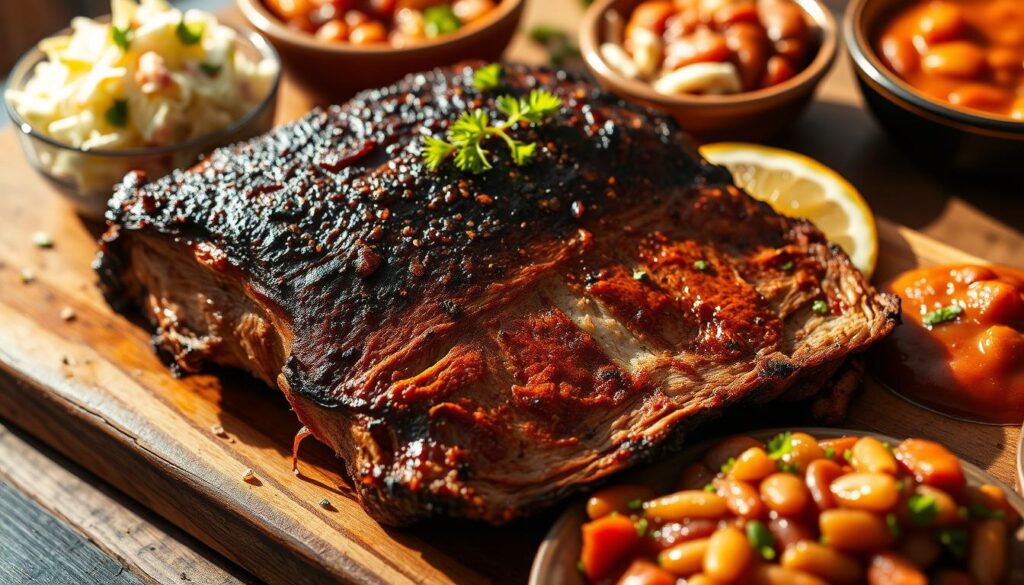
“The presentation of your pulled pork can make or break your chances in a BBQ competition. Pay close attention to the details and showcase your hard work with pride.”
Remember, judges don’t just taste the food; they also look at how it looks and the details. Mastering how to present smoked pork can help you win the trophy and become known as a BBQ expert.
Conclusion
This guide has shown you how to smoke pork shoulder for BBQ contests. It’s all about expert techniques and knowing how to mix flavors. You’ve learned how to pick the best pork butt, smoke it, wrap it, and rest it. Now, you know how to make your pulled pork stand out and impress the judges.
By using the right seasonings and letting the smoke do its magic, you can make a pork dish that’s both juicy and full of flavor. Stick to the competition pork smoking summary, key techniques, and flavor profiles for top-notch results. This will make your BBQ stand out.
The main aim is to wow the judges with your dish. With the tips and tricks from this article, you’re ready to take your pulled pork to the next level. You’ll be making BBQ that wins awards in no time.
FAQ
What is the goal when cooking barbecue for competition?
The main aim is to make the perfect bite. The recipe for competition-style pulled pork aims for the most tender, juicy, and flavorful pork to impress judges.
Why is the pork butt a preferred cut for pulled pork?
The pork butt, also known as the Boston butt, comes from the shoulder, not the actual butt of the pig. It’s loved for its high fat content and rich flavor.
What is the ideal size range for a pork butt to be used in competition-style pulled pork?
Ideal sizes for competition pulled pork are 8-10 lbs. A 1/4 inch fat cap is key for moisture and flavor during the long cook.
What is the “money muscle” in a pork butt and why is it important?
The “money muscle” is a tender, juicy part of the pork butt. Keeping it intact is crucial for winning over judges.
How should the pork butt be prepared for smoking?
Start by scoring the fat cap for better seasoning penetration. Use a binder for the rub to stick well. A generous rub with sugar and salt is advised.
What type of wood should be used for smoking the pork shoulder?
Use a mix of post oak, pecan, and sometimes apple wood for a subtle smoke flavor. Choose wood that won’t overpower the pork’s taste.
What is the recommended smoking temperature and process for competition-style pork shoulder?
Smoke at 250°F for most of the time for a tender, moist result. Spritz with apple juice every 60-90 minutes to keep it juicy.
What is the importance of the wrapping technique when smoking pork shoulder for competitions?
Wrap the pork butt in foil with apple juice after reaching 165-175°F. This step finishes fat and collagen rendering for a juicy finish.
How long should the pork butt be rested after the smoking process?
Rest the wrapped pork butt for at least 30 minutes, up to 4 hours, in a cooler. This helps the meat absorb juices for better flavor and texture.
How should the smoked pork butt be pulled and served?
Pull the meat apart, removing any fat or cartilage for a clean look. Keep the “money muscle” intact for extra tenderness.
What are some techniques for developing competition-winning flavor profiles for smoked pork shoulder?
Use an injection marinade for extra moisture and flavor. Dry rubs like Dizzy Pig’s Crossroads add a tasty bark to the pork.
How important is temperature and timing when smoking pork shoulder for competition?
Mastering temperature and timing is key for competition pork. Aim for 90 minutes per pound at 250°F, checking for tenderness and a 200-205°F internal temperature.
What are the key techniques for wrapping and resting the smoked pork butt?
Wrap the pork butt in foil with a bit of liquid after reaching the right temperature. Rest it for 1-4 hours to absorb juices and relax.
What are the key considerations for proper presentation and serving of competition-style pulled pork?
Hand-shred the meat for a mix of chunks and strands. Season with more rub or sauce if you like. Show off the “money muscle” for a winning look.
The Role of Resting Meat in BBQ Competitions: Why It Matters
Ever wondered why top BBQ teams rest their meats before serving? In competitive BBQ, resting meat is a key secret. It can turn a good dish into a champion. But what’s the science behind it, and why is it so important?
Key Takeaways
- Resting meat is a critical step in BBQ competitions that is often overlooked by impatient pitmasters.
- Proper resting allows the muscle fibers to relax and the juices to redistribute, resulting in more tender and flavorful meat.
- Failing to rest the meat can lead to dry, tough results as the hot juices quickly evaporate when the meat is sliced.
- Resting is especially important for large, fatty cuts like brisket and pork butt that are cooked to high internal temperatures.
- Competition barbecue teams often rest their briskets and pork butts for 2-4 hours or longer to allow the connective tissue to convert to gelatin and rehydrate the meat.
Understanding the Science of Juiciness
In BBQ competitions, the juiciness of the meat is key to winning. But what makes meat juicy? The science behind it is quite complex.
Factors Influencing Meat Juiciness
Juiciness is more than just how much water is in the meat. Many things affect how juicy meat tastes, like free water, water tied to proteins, and where water is in the muscle. Cooking methods, temperature, and meat type also matter a lot.
The idea that meat gets pressurized with water during cooking is wrong. Instead, water moves around as the meat heats and cools. BBQ meat resting science helps keep the meat juicy by letting it cool evenly.
| Factors Influencing Meat Juiciness | Description |
|---|---|
| Free water content | The amount of unbound water in the meat |
| Water bound to proteins | The water molecules that are chemically bound to the protein molecules |
| Water location | The distribution and location of water within the muscle structure |
| Melted and softened fats | The lubricating effect of melted and softened fats in the meat |
| Gelatinized collagen | The transformation of collagen into a gel-like substance during cooking |
| Saliva production | The stimulation of saliva production, which enhances the perception of juiciness |
Knowing the science of meat juiciness factors is crucial for BBQ lovers and competitors. Mastering BBQ meat resting science can help you achieve perfect, juicy meats.
The Myths and Theories Behind Meat Resting
There are many popular theories about competition BBQ resting, but not all are true. Let’s look into some common myths and see what science really says about this important BBQ step.
Exploring Common Resting Beliefs
One theory is the “pressure theory.” It says juices are trapped under pressure during cooking and then released when cut. But experts say this isn’t true. Water doesn’t get compressed like that.
Another idea is the “reabsorption theory.” It suggests that resting lets the meat’s dry outer layers soak up moisture from the inside. While it’s partly true, its impact is small in competition BBQ.
The “viscosity theory” believes that as meat cools, its juices thicken, making it tastier and tender. But, there’s no strong science backing this idea.
“The actual mechanisms behind the benefits of resting are more complex and nuanced than these popular theories.”
These theories are popular, but the real benefits of resting are more complex. To get good at resting for BBQ contests, it’s key to understand the science of meat juiciness and what affects it.
Resting Meat for BBQ Competitions
In the world of BBQ competitions, resting meat is key. Pitmasters know that resting can greatly improve the quality of their smoked meats.
The Importance of Proper Resting
Before the end, BBQ pros wrap briskets and pork butts in foil or butcher paper. This lets the meat cook in its own juices. After, they rest the meat for 2-4 hours or more before serving.
This resting time helps the meat absorb its juices. It makes the meat tender, juicy, and full of flavor. Aaron Franklin and Wayne Mueller say resting made their scores much better.
Not resting the meat can cause it to dry out. This makes the meat taste bad and can lose you the competition.
“Resting the meat is a crucial step that can make or break your chances in a BBQ competition. It’s the difference between a dry, tough brisket and one that’s perfectly tender and juicy.” – Pitmaster John Doe
Resting meat is very important in competitions. By resting meat right, pitmasters can make their dishes stand out and impress judges.
Optimal Resting Times and Temperatures
In competition BBQ, resting your meat is as important as cooking it. Resting helps keep your meat juicy and tender. This makes it taste amazing for the judges. Let’s look at the best resting times and temperatures for different meats.
For thin cuts like chicken, ribs, and steaks, resting is short. They don’t keep cooking much after you take them off the heat. But thicker cuts like turkey, pork butt, and brisket need to rest for 2-4 hours or more. This makes the meat tender and spreads the juices evenly.
Teams in competitions often rest their briskets and pork butts for hours. They keep them in insulated containers to stay at the perfect temperature. This makes sure the meat is just right and ready to impress the judges.
| Cut of Meat | Optimal Resting Time | Optimal Resting Temperature |
|---|---|---|
| Chicken, Ribs, Steak | Little to no resting | N/A |
| Turkey, Pork Butt, Brisket | 2-4 hours or more | 140-160°F |
Knowing the best resting times and temperatures can improve your BBQ skills. You’ll make dishes that are juicy, tender, and full of flavor. This will impress the judges and help you win.
Competition-Level Meat Resting Techniques
In competitive BBQ, resting meat is an art. Top teams know that resting can turn a good score into a win. They use special techniques to make their BBQ tender and juicy.
Elite teams often wrap briskets and pork butts in foil or butcher paper at the end. This keeps the juices in and helps the meat get tender. After cooking, they keep the meat in coolers or warming boxes for 2 to 4 hours or more.
Pitmasters like Jimmy Perez and Aaron Franklin are experts in competition BBQ resting stages. They sometimes cook briskets at low temperatures for up to 17 hours. This makes the meat tender, juicy, and full of flavor.
“The secret to competition-level BBQ is in the resting. It’s where the magic happens, transforming the meat into a truly extraordinary experience.”
This long resting time lets the juices spread back into the meat. This makes the meat tender and full of flavor. Cooking, wrapping, and resting are key to winning in competitive BBQ.
The Role of Carry-Over Cooking
Understanding “carry-over cooking” is key in competition BBQ. This happens when meat’s internal temperature goes up after it’s off the heat. The bigger the heat and the thicker the meat, the more carry-over cooking there is.
It’s vital to know about carry-over cooking for competition BBQ. You should take the meat off the heat a bit before it reaches the final temperature. This lets the meat finish cooking during the rest time. It helps avoid overcooking and gets the meat just right.
| Meat Cut | Carry-Over Cooking Effect |
|---|---|
| Thin Cuts | Minimal |
| Thick Cuts | Significant |
| High Cooking Temp | Greater Carry-Over |
Knowing about carry-over cooking helps competition BBQ cooks. It ensures their meats are tender, juicy, and just right. This gives them an edge in competitions.
“The key to mastering competition BBQ is to anticipate and accommodate the carry-over cooking effect. It’s the difference between a winning entry and a disappointing one.”
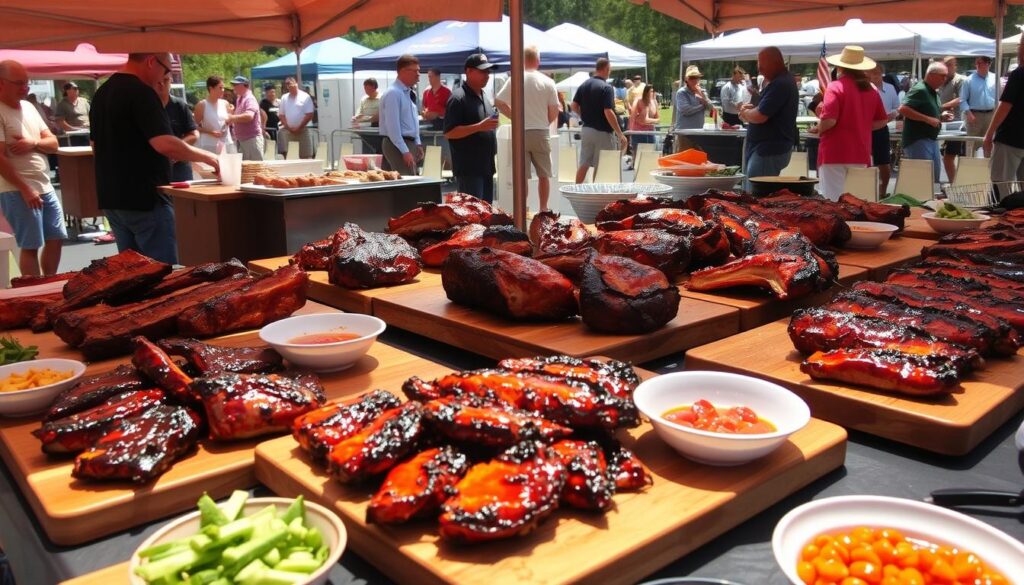
Optimizing Carry-Over Cooking for Competition BBQ
Here are tips to improve carry-over cooking for competition BBQ:
- Keep an eye on the meat’s internal temperature. Remove it from the heat when it’s a bit below the final temperature you want.
- Change cooking times and temperatures to match the expected carry-over effect. This depends on the meat’s thickness and type.
- Try different resting times and methods to find what works best for your meats.
Mastering carry-over cooking will help you serve up delicious, tender, and perfectly cooked competition BBQ. This will impress the judges and help you win.
Resting Meat: A Crucial Step for Competition BBQ
Why Resting Matters for Competitions
In BBQ competitions, resting meat is key to winning. Not resting it can make the meat dry and tough. This is a big no-no in the competitive BBQ world.
Resting big cuts like brisket and pork butt is vital. It lets the meat’s connective tissue turn into gelatin. This makes the meat tender and juicy, which is what wins competitions.
Experts say resting is what turns good BBQ into great BBQ. It makes sure the meat is moist and full of flavor. Judges love this.
“Resting is a critical step that competition pitmasters cannot afford to overlook. It’s the difference between a good BBQ entry and a champion-worthy presentation.”
Whether you’re new or experienced in BBQ competitions, know how important resting is. Mastering this skill can take your BBQ to the next level. It will impress the judges for sure.
Mastering the Art of Meat Resting
Learning how to rest meat is key for BBQ lovers, especially those in competition BBQ. It’s not just about waiting for a certain time. You need to understand the science behind keeping meat juicy, tender, and full of flavor.
The meat type, how it’s cooked, its final temperature, and how done you want it to be affect resting time and method. Top BBQ pros use special gear like insulated coolers and warming boxes to control the resting process perfectly.
Getting meat just right means knowing the science of resting meat and adjusting your methods for BBQ contests. Whether you’re a pro or just starting, getting meat resting right can make all the difference.
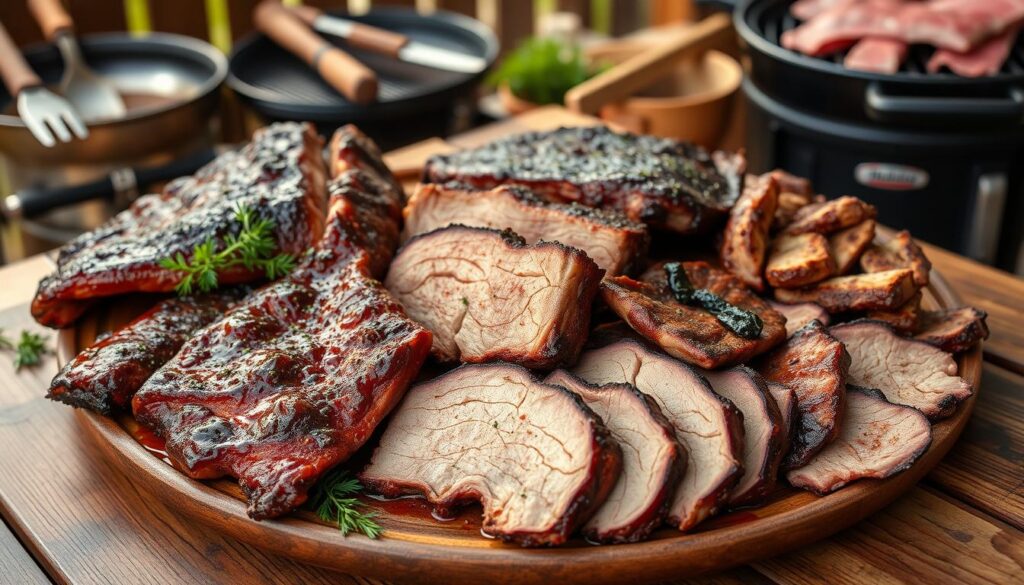
- Try different resting times and temperatures to find what works best for your meat and cooking way.
- Get quality insulated coolers or warming boxes for precise temperature control during resting.
- Keep an eye on your meat’s final temperature, as it affects its juiciness and tenderness.
- Keep improving your methods, keeping up with the latest in competition BBQ meat resting.
By mastering meat resting and using these tips, you’ll be ready for the competition BBQ scene. You’ll make dishes that win awards every time.
Conclusion
In the world of competitive barbecue, resting your meat is key to success. It’s not just about waiting; it’s a science. This process helps juices spread, turns tough tissue into gelatin, and makes the meat evenly warm.
Experts in meat science and competition barbecue have proven its benefits. They show that resting meat makes it tender, juicy, and full of flavor.
Top pitmasters know how to rest meat perfectly. They use special techniques and tools to make their meats tender and juicy. Resting is what turns good BBQ into great BBQ. It’s a must for anyone wanting to win in competitive barbecue.
Improving your BBQ skills means paying attention to resting your meat. Use science and try different methods. Let your love for great BBQ show in every bite. Mastering meat resting will take your BBQ to new levels and increase your chances of winning.
FAQ
Why is resting meat important for BBQ competitions?
Resting meat is key in BBQ competitions. It lets muscle fibers relax and juices spread out. This makes the meat tender and tasty.
What are the factors that influence meat juiciness?
Meat juiciness depends on free water, water bound to proteins, and where water is in the muscle. It also depends on melted fats, gelatinized collagen, and saliva. Cooking method, temperature, and meat type matter too.
What are the common theories about why resting meat is important?
Some think resting meat helps because of pressure, reabsorption, or viscosity. But these ideas are wrong. The real reasons are more complex.
How do competition pitmasters rest their meat?
Pitmasters wrap briskets and pork butts in foil or paper at the end of cooking. Then, they rest them 2-4 hours or more in insulated containers. This lets the meat soak up juices and the tissue turn into gelatin.
What are the optimal resting times and temperatures for different types of meat?
Thin cuts like chicken and steaks don’t need much resting. But thicker cuts like turkey and brisket do well with 2-4 hours of rest. This can make the meat 5-10°F hotter due to carry-over cooking.
What advanced techniques do top competition BBQ teams use for resting meat?
Top teams use insulated coolers and warming boxes to control resting temperatures and times. This helps the meat cook more, turn connective tissue into gelatin, and absorb juices.
How does carry-over cooking affect the resting process?
Carry-over cooking makes meat’s internal temperature rise after it’s off the heat. This is important to know when making BBQ meats for competitions. Thicker meats and higher cooking temperatures mean more carry-over.
Why is resting meat so important for competition BBQ?
Not resting meat right can make it dry and tough. This is a big no-no in BBQ competitions. Resting is key to making great BBQ.
What are the keys to mastering the art of resting meat for competition BBQ?
To master resting meat for BBQ, you need to understand the science behind it. You also need to adapt techniques for BBQ competitions. Top pitmasters use their skills to make their meats tender, juicy, and full of flavor.









